|
To put it mildly, it's been a dreadful summer for astronomy in Washington, DC. The primary culprit is wildfire smoke, which seems to waft into the city with every clear night. As a professor whose primary preoccupation is climate change - and as a dad - the smoke fills me with dread. It is alarming for any number of reasons, but it has extra significance for those enamored with the night sky. The atmosphere is likely to be less transparent on a warming planet, owing either to wildfire smoke or aerosols intentionally seeded into the stratosphere. That second possibility is known as solar geoengineering. It's cheap (compared to the cost of global warming), it's likely to be effective (despite a litany of troubling side effects), and I'm increasingly convinced it will happen within twenty years. In fact, this summer the White House Office of Science and Technology Policy released a primer that more or less accurately describes where the science of geoengineering currently stands. If plans currently on the drawing board someday take off, astronomy as a science and hobby will change - quite possibly for the rest of our lives. In all likelihood, planetary observation won't change much, and Electronically-Assisted Astronomy will still reveal deep space marvels. Yet my suspicion is that traditional telescopes - including big Dobsonian reflectors - will be far less effective for observations of diffuse objects far from our Solar System, such as nebulae or galaxies. You've been warned! Anyway, I did manage to see one spectacular sight in DC this summer. In May - just before the worst of the smoke surged south - a supernova exploded in the Pinwheel Galaxy. I hauled my EVScope to a nearby field and had a look. The above picture is all I managed to capture, but the view through the eyepiece was far more impressive. I still can't believe I managed to see an exploding star - and, in all likelihood, the formation of a black hole - 21 million light years from Earth. More recently, I travelled with my family to Winnipeg. Despite its closer proximity to the many wildfires burning through British Columbia, the city has been less affected by wildfire smoke than Washington, DC. The sky is not quite free of smoke, but it's a good deal more transparent than it's been further south. This was my first trip to the city since the pandemic, and I'd nearly forgotten that I cobbled together a fairly impressive little observing setup here. Four years ago, I had a Twilight I mount delivered to my in-laws. I also purchased a C6 shortly after I was last here, and it was still in the box when I arrived this time. I unpacked it with some trepidation - the last C6 I purchased was damaged upon arrival - but not to worry: to my relief, the little telescope was in perfect condition. With everything assembled, I was struck by how well the C6 fits on the Twilight mount. I don't think it could handle a C8, but a C6 is just about perfect. It's quite stable, convenient to look through, and remarkably easy to move. In fact, I can lift mount, tripod, telescope, diagonal, and eyepiece - everything - above my head with ease. I swapped out the standard Celestron diagonal - a child's toy - with a TeleVue Everbrite, and used a Baader Mark IV Zoom for an eyepiece. The field of view, I must admit, is a little too narrow, but then a Schmidt–Cassegrain really isn't a wide-field instrument. I was gifted one clear night after another since arriving here, and used the first two nights to admire the Moon. This far north, it doesn't rise far above the horizon right now, and it is tinted a beautiful pinkish-gold by the diffuse smoke in the upper atmosphere. Seeing was mediocre at best, but the telescope turned out to be well collimated, and the view was quite striking. As the above image attests, the Moon was not as sharp as it would be through one of my refractors. Even in mediocre atmospheric conditions that prevailed here, the Takahashi, I'm sure, could have shown me more. But when you consider the relatively low cost of a C6 - albeit much higher than it was pre-pandemic - the telescope is a remarkable performer. I was particularly impressed by how cleanly it snapped into focus; in fact, finding focus seemed a little easier with the C6 than it is with my refractors. I was genuinely delighted to discover that Saturn now rises high enough above the horizon to observe at around midnight. The planets might have drawn me outdoors this summer despite the wildfire smoke, but often they had set before I could step outside. Well - Saturn, at least, is back.
The C6 offered a really satisfying view of the planet, with the Cassini Division clearly visible at 75x. I'm not sure my Takahashi would have done that much better, given the seeing. In a cooperative atmosphere, I have no doubt that the refractor would outpace the Schmidt–Cassegrain; there is a delightful crispness to its views that the stubbier telescope can't quite match. And of course, it never needs to collimate or acclimate (for long). Nevertheless, I was stunned when, later, the C6 showed me Arcturus as a perfect orange point: something I had not expected from a Schmidt–Cassegrain. For those less obsessed than I am with getting the absolute best views that a (modest) aperture can provide, I suspect it would be impossible to justify the extra cost of a 4" apochromatic refractor over a C6. Well done, Celestron! Anyway, I had a truly wonderful half hour on the porch, the crickets chirping nearby as I admired the ethereal beauty of Saturn's rings. I was struck by how much their tilt relative to us has changed over the past year, and I fear that they will - briefly - disappear from view entirely in the months to come. It will be fleeting. Soon enough, the rings will return, and the planet will regain its grandeur. For me, one of the joys of astronomy lies in the knowledge that however badly we muck up our planet, countless wonders glitter beyond our reach. With or without us, it's a beautiful universe.
0 Comments
Binoculars have long frustrated me. While I've thrilled at catching glimpses of rocket launches or lunar craters with big Celestron binoculars here in Washington, DC, I could never hold them steady enough to make out more than blurry glimpses. I opted for more manageable binoculars, but still: no matter what I did, the view was always disappointing. Eventually I gave up and decided that binoculars were just not for me. Then I learned about image stabilized binoculars: remarkable little devices that use gyroscopes and moveable lenses to cancel the inevitable vibrations caused by human hands. The high cost and relatively small size of these binoculars at first convinced me that it just wouldn't be worth it to buy one. Eventually, however, I found that I'd accumulated a heap of eyepieces I no longer used, and after selling them I took the plunge. I bought a pair of Canon 12x36 Image Stabilization III binoculars. When they arrived, I decided to try them out on the abundant birds in my backyard. I'm not a bird watcher - the one time I went on a bird watching tour at a conference, I was nearly abandoned in the middle of a desert - but I have to say, I was absolutely floored by the view. It really felt like the bird I was looking at - a female cardinal high up in the canopy - was right there in front of me on the table. The view was absolutely crisp, razor-sharp with no false color, and better yet: it was stable. It's hard to emphasize enough what a difference that makes. I was eager to see what I could make out on the planets, which had become very prominent in the mornings. When I tried, however, I was disappointed. This time I noticed some false color, and the image wasn't quite sharp enough for me. I figured, sadly, that even the best binoculars might not have much value for me in astronomy. Yet last night I couldn't resist the temptation to try out the binoculars one more time. The last "supermoon" of the year was rising, the Perseid meteor shower was peaking, and I really wanted to go to my favorite park. It's a long and painful hike with a telescope, but easy and fun while riding a scooter with one-pound binoculars in a backpack. I zipped out at around 11 PM, and made it to the park in no time.
The very first thing I saw as I reached my preferred observing spot was a bright meteor: an auspicious start if ever there was one. When I looked at the huge, golden Moon, however, I was again disappointed: it was just a bit blurry, with too much false color. This time I carefully adjusted the binocular's collimation and focus, waited a few minutes for it to acclimate, and tried again. What a difference! Now the Moon was wonderfully sharp - like those birds in my backyard - and to my astonishment the view really wasn't much less impressive than it is with my Takahashi refractor at low magnifications. The amount of detail I could make out was nothing short of miraculous. Then I turned to Saturn, and could hardly believe it when I easily made out its rings. Jupiter was rising above the horizon, and sure enough: there were its moons, perfectly clear in binoculars with an aperture of just 36mm. There was something exhilarating about how easy it all was. The binoculars are little bigger than my hand, and of course they required essentially no setup. But there I was, with bats fluttering overhead (I saw one through the binoculars), admiring the heavens. After about 15 minutes, I had that giddy feeling I sometimes get during my best nights under the stars - and since I wanted to leave on a high note, I hopped back on my scooter and sped home. Image-stabilized binoculars cost a lot more than a decent pair of regular binoculars (but a lot less than premium binoculars with high-quality optics). However, I'm now convinced that it's difficult to compare them to their lower-tech cousins. It's a completely different experience to use them. Because their views are stable, looking through them is more like using a telescope than regular binoculars - with the added benefit of the three-dimensional experience that binoculars (or binoviewers) uniquely provide. I have a real weakness for little instruments that provide outsized views (it's why I loved my TV 85 as much as I did). After last night, I have to conclude that the diminutive Canon 12x36 is, quite possibly, the most impressive optical instrument I've ever tried out. It doesn't often work out this way in amateur astronomy, but sometimes big things really do come in little packages. Two things have kept me from posting - and observing - these last three months. First: the weather. This has been about the worst stretch of cloudiness and terrible seeing that I can remember in DC. On the rare nights that seemed promising, conditions worsened just as I was about to step outside with my gear. I remember a similar though slightly less atrocious stretch of bad weather last year at around this time, when I was so impatient to see whether my new Takahashi FC-100DZ really provided better views than the Takahashi FC-100DC I had just sold. Now I wonder: is this the start of a new trend, or perhaps a regression to a mean that existed before I started observing whenever I could? But second, I bought a home. That turned out to require a lot of work - more than enough to keep me in, even if the nights had been clear. The new place is a condo with a fenced-in backyard. A backyard! It's what I've always dreamed of. Okay, it's small, and it's mostly for the kids. But when my wife saw the yard for the first time, she reported a gap between the trees that "might be good for your telescopes." My heart skipped a beat. Can you ask for anything more from a partner? We moved in just two weeks ago. It's been quite cloudy since, but then, last night, the clouds parted, and the forecast called for better than average seeing and transparency. So I woke up at 4 AM, ready to go. I didn't have to go far: whereas I've long had to walk for ten or fifteen minutes to reach a nearby(ish) park, now I just step out the back door. What a thrill! Admittedly, the backyard affords only pockets of open sky, nearly all of them facing east-southeast. When the overhanging trees sprout their leaves this spring, most of those pockets will fill up. For now, however, I was thrilled to see Ursa Major, Hercules, and Lyra all hanging overhead. There are some streetlights nearby, but they're not blinding and their light points down at the ground. For a condo backyard, you can't ask for much more. I slipped outside with my EVScope 2. That's right: I've upgraded from my first-generation model. The sequel has a higher-resolution sensor that shows more of the sky, along with a much-upgraded eyepiece. Those were exactly the upgrades that I've yearned for, so when I heard about them I had to pounce. The EVScope 2, however, is not exactly cheap. I bought it at about $1000 more than the original, which of course I had to sell to make the purchase remotely possible. When I stepped outside, it was -7 degrees Celsius - that's about 19 degrees Fahrenheit. To cover the approximately 30 degree (Celsius) delta between inside and outside temperatures, the EVScope required a good thirty minutes to acclimate. When I tried to capture an image before it had cooled down, it was predictably blurry and unsatisfying. But after the telescope had reached ambient temperature, the view was rock-steady. The EVScope 2 seems to align itself even more easily than the original. It honestly takes no more than ten seconds or so, and then it's ready to slew anywhere in the night sky. Objects also appear more consistently centered in my view after the telescope finds them. I'm not sure what accounts for this; is there really something about the EVScope 2 that could be responsible for it? I'm not sure. Maybe I was unlucky with my first unit. But the improvement sure is handy. M51 - the Whirlpool Galaxy - is always a favorite target. Last night it was a little close to the balconies above us, which required me to reposition and realign the telescope a few times to get a decent angle. Then, in just six minutes, I got the above picture. I think it's about as good as the image I got in Lewes, Delaware last summer, with the EVScope 1 under far darker skies. I think the new version handles light pollution far better than the original; certainly it seems to take far longer exposures before the image starts brightening around its edges. The amount of detail on M51 is really extraordinary when you consider it took just a few minutes to get that shot in a light polluted, Bortle 7-8 sky. As readers of this site will know, I get such a kick out of M57, the Ring Nebula. With a four-inch refractor in DC it is just barely - barely - there, and then only with averted vision. A larger refractor shows more, but not much. The EVScope, of course, makes it so obvious, and so colorful, in just a few minutes. The EVScope 2 provides meaningfully less grainy images; the nebula looks smoother here, and much more true to life. As the eastern sky showed its first signs of brightening, I turned to M13, the Hercules Cluster, to close out the night. There's just something about a globular cluster that is always such a thrill for me, and of course the great Hercules cluster most of all. This view did not disappoint: easily the rival, I thought, of what the EVScope 1 revealed under far darker skies. The EVScope 2 seems to more consistently permit longer exposures; I found that my phone frequently lost its connection to the EVScope 1 when my exposures passed ten minutes or so. Maybe that was just my unit, but still: it was nice to easily cruise on to 12 minutes on an object like M13.
I kept slipping back inside to warm my fingers as the telescope started taking exposures. That's one wonderfully convenient luxury of a backyard. Still, I didn't lose that early morning magic, when all seems still, even in the heart of a city - breathless with anticipation for the rising Sun. There's just nothing quite like that feeling of being outside with a telescope in the hours before dawn, gazing millions of years back in time and space. We've had some wonderfully clear, autumnal nights over the past week, with Jupiter and Saturn riding high in the evening sky and the Moon waxing and waning nearby. I'm teaching what may be my favorite course at the moment - about the human history of nearby celestial bodies (what I call "neighboring worlds"), and a special highlight is taking my students out for a night with a telescope. I have now accumulated some very fine refractors, however, and I worried about how they'd fare after being handled by twenty students. To that end, I drew on my research funds to buy a William Optics Zenithstar 81. It's a beautiful little refractor, and I figured that it would be more than adequate to give my students an impressive view of the Moon. For their first assignment, they need to find a feature on the Moon and then write a history of how people have understood, imagined, explored, or planned to exploit that feature. A few things immediately struck me about the Zenithstar. First, it costs about a third as much as the TeleVue 85 I used to own - less than a third, when you consider it comes with its own mounting rings, dovetail, Bahtinov mask, and carrying case - despite giving up only four millimeters in aperture. Second, its build quality looks to be on par with the very best telescopes I own and have owned, with the possible exception of my TEC 140. Third, it seems to weigh less than the FS-60Q I once owned, and much less than the TV 85, and its sliding dew shield makes it much more compact than either telescope. It was really easy to carry the telescope to a darker corner of campus, and there set it up on my DM-4 mount and Berlebach Report tripod. Almost immediately, the Plossl eyepieces I'd decided to use provided beautifully crisp views of the nearly fully illuminated Moon. The students who had started to gather were predictably impressed. When we found we had a few minutes to spare at the end of the evening, I decided to try showing them Jupiter and Saturn. At about 56x, the planets were small, but beautifully sharp and clear. Many of my students were awestruck; they had a hard time believing that they could really see the major cloud belts of Jupiter and the rings of Saturn from downtown DC. Experiential learning is always special; it makes the otherwise abstract concepts we discuss in class come alive for my students, and it can provide lifelong memories. I for one was stunned by the performance of the little refractor. It is, by far, the most portable telescope I've owned, and when it comes to performance it really doesn't give up much to the TV 85. I loved my TV 85, but I would have a hard time recommending that telescope as a go-to instrument when the Zenithstar seems to provide so much more value for the cost. Last night conditions were even better, and now I resolved to head out with my biggest telescope: the TEC 140. The weight of the telescope, tripod, and mount means that I really can't haul everything to my favorite field. I targeted the little alcove next to a church that I've used over the past year, yet when I arrived as I was dismayed to find that the church had installed a new streetlight that completely ruled out observing there. I wandered about, dragging my heavy gear, until I decided to head down to a little amphitheater near the National Cathedral. There I found a perch that, if I moved around a bit, afforded me a view of Jupiter, Saturn, and the Moon through the canopies of nearby trees. When I swung the TEC to Saturn, I was mesmerized. This was only the second time I'd used the TEC, and the first time in good seeing. In those conditions, Saturn looked absolutely stunning, like a beautiful jewel set in a velvet background. Its many moons were brilliant and sharp, and the shadow of the planet on its rings gave me the rare sense that I was actually seeing a world in three dimensions (often, objects in the eyepiece look flat, and therefore two dimensional). Cloud details were obvious on the planet's yellow-white disk. Switching over to Jupiter provided an even more spectacular revelation. The TEC provided what may have been my best-ever view of the planet, with more cloud belts and zones than I could count, delicate, feathery structures within those belts and zones, and a perfectly obvious, brown "barge" - an elongated, oval cloud feature - near the planet's equator. There was a contrast and vibrance to the planet's colors that you just don't get with a smaller refractor, and all four Galilean moons were visible as clear disks, rather than points of light. Jupiter and Saturn soon wheeled behind the trees, so it was time for the waning gibbous Moon. Once again, I was dumbstruck. The Moon wasn't that far above the horizon, but at 163x there was just such a wealth of subtle, perfectly sharp detail, from jumbled crater peaks to winding rilles and delicate scarps. The terminator was perfectly positioned to throw mountain after mountain in sharp relief, and in exploring them I eventually lost track of time. Then a giant cricket jumped on my pants, I realized in shaking it off that it was past midnight, and I began packing up for the painful trek home.
The TEC 140, I have to say, is noticeably better than the APM 140 I've also raved about in these pages. I'm not sure it's worth the extra cost; certainly I could never have afforded the difference if I didn't use the telescope for my research and writing (which means I could draw from my research funds to buy it). I realize how lucky I am, and I hope I can keep using the telescope for a lifetime. It won't be that often, however, until I manage to own a backyard; as wonderful as the telescope may be, it's also hard to transport more than a few minutes from our home. On November 16th, the sky was clear and, after a glorious sunset, atmospheric seeing promised to be mediocre but transparency was predicted to be superb. With no Moon in the sky, conditions were right to take the EVScope for another spin. I've now (separately) purchased the backpack that's sold with the EVScope; my rolling case, I suspect, my knock the telescope out of alignment. When I set it up this time, collimation was just about perfect. I made a couple tiny tweaks - again, this took seconds - and then rapidly achieved fine focus with the built-in Bahtinov mask. It was cold and I was exhausted, so I figured I would only take two ten-minute exposures of the Andromeda and Triangulum galaxies. Moments after the telescope slewed to Andromeda, I heard some rustling in the distance and noticed a dim orange glow, appearing and disappearing. Then the sounds of muttering wafted over on the breeze. It seemed I was sharing my park - and I had the disquieting feeling that I was being observed. After about eight minutes or so, I thought a third shadow joined the two in the distance, and then the rustling got closer. The conversation, it seemed, was definitely in Russian. Suddenly a flashlight turned on; there were three people, and they were walking directly towards me. I greeted them: "Hello? Hi!". At that, one of them exclaimed "oh my God!", and then all three of them darted to the side, behind a bush, and disappeared. The sounds receded into the distance. That was unsettling. Fortunately, after ten minutes the Andromeda exposure turned out nicely, considering the light pollution. Collimation and fine alignment really makes for much tighter stars and far better images, though I imagine things would be better still in superior seeing (and, of course, under a darker sky). Now it was on to Triangulum. It wasn't long ago that I managed to spot the galaxy with the FC-100DC, under darker skies some distance from DC. I noticed only a slight brightening of the sky, with averted vision, in what I could just perceive - or imagine - to be a spiral pattern. Clearly observing the galaxy now, from downtown, is a particular thrill. I don't know why, but Triangulum in particular has always captured my imagination. Maybe it's because it gets so little attention compared to the two giants of our Local Group of galaxies, or maybe because it's a face-on galaxy with distinctly knotted spiral arms . . . I'm not sure why, exactly. In any case, I find that the EVScope does a particularly good job on this galaxy (see above). And again, during the exposure I was in for a shock. With a loud thump and a lot of growing, a rabbit suddenly rushed right by the telescope, a fox in hot pursuit. The fox stopped short of my location with a snarl, then scampered - its little legs a blur - over a hill and behind a bush. Both fox and rabbit were no more than six feet from me. I couldn't wait to tell my four-year-old daughter in the morning. Anyway, after a few more minutes the Triangulum exposure was done to my satisfaction. I packed up the telescope, warmed my chilled fingers, and walked home. Suffice it to say, I've really started to enjoy the EVScope. A few days after my strange night with the EVScope, an ad appeared on AstroMart that forced me into hours of tortured thought (usually while attempting to get my one-year-old to sleep). Here was a Takahashi FC-100DZ, used only once and in pristine condition. As I've mentioned before, this year I've been tempted to swap my 100DC for a DZ. The DZ has better color correction and its optics might be marginally sharper, on average, though both improvements may be difficult to detect visually (I read many opinions, and they seem to differ). You can read a great breakdown of the relative merits of the four current FC-100 models here. I've resisted the urge to swap the DC for the DZ because, first, the hassle and expense seemed daunting, and second, the DC's weight is supposed to be lighter. The difference in weight, I concluded, outweighed (sorry) the marginal difference in optical quality. Yet the four-inch refractor is my most used telescope, and now I couldn't resist the urge to upgrade to maybe the finest refractor of this size ever made. So, I bought the DZ and sold my DC (along with some other stuff to make up the cost). I have to say, the comparison between DC and DZ surprised me in a few ways that aren't covered elsewhere. First and for my purposes most importantly, the weight difference between the two telescopes is scarcely noticeable. In the above pictures, you can see the DZ in a configuration for short-range, daytime viewing. However, to reach focus for astronomical viewing you must detach one of the couplings, and that makes the DZ noticeably lighter. It is then also more compact than the DZ when the sliding dew shield is tucked over the optical tube. Second, the most important couplings of the DZ do not screw apart but rather use thumbscrews and compression rings. You can also use that system to attach a diagonal, and I can't tell you what a difference it makes. I actually detest the Takahashi fetish for stacking screwable couplings in the visual back. The couplings, I've found, tend to stick together, and they're not wide enough to grip easily. It's easy to damage them (cosmetically) by applying too much pressure (I did as much to one of the DC's couplings). The new system brings the DZ in line with most other fine refractors, and it is just such a relief. Third, to balance the telescope - using just about any eyepiece - the clamshell tube holder must sit farther from the visual back than it does with the DC. This may seem like a very minor detail, but it provides more room for a red dot finder (RDF) just in front of the visual back. My Rigel QuikFinder RDF is now in a more comfortable position, and it's those little details that can make a real difference in the field. Fourth, the focuser is just a bit nice. Its knobs are metal - not plastic, as in the DC - and the feel is a bit smoother (though I did need to adjust the tension knob for my big Delos eyepieces). I sold Takahashi's two-speed focuser upgrade with the DC, and although I will no doubt miss the fine focus on the DZ, I didn't like how the two-speed add-on left some daylight around the gear housing. On the DZ, I'll stick with the stock focuser. That focuser, by the way, allows me to reach focus with all my eyepieces - something that was just out of reach for the DC. Finally, although the sliding dew shield is very smooth and easy to use, its tightening screw does leave a subtle mark on the optical tube that is noticeable when the dew shied is deployed. I wonder if the previous owner tightened the screw a bit too much, but I doubt it; I think this is just a natural consequence of the technology. It only matters if you're obsessive about the condition of your equipment - but Takahashi telescopes are so beautiful that they tend to bring out that obsession. Last night, and against my better judgement, I took out the DZ for the first time. I say "against my better judgement" because transparency was mediocre and seeing was poor. It's a recipe for disappointment to take out a new telescope in such conditions. I couldn't resist, but I did set up near the cathedral, closer to my house so I could hurry back if observing disappointed.
And did it? Well, a look at Mars did clearly reveal that the atmosphere would not be my friend tonight. And yet, I could plainly make out no fewer than three large dark albedo markings, along with that brilliant south polar icecap. Turning elsewhere, Rigel A and B were laughably easy to split in the poor seeing, and Orion was beautiful even before it emerged from the light pollution near the horizon. So could I make out an optical difference between the DC and DZ? Not after one night of poor seeing. Mars did seem a bit yellower than it does through the DC, and certainly I could detect absolutely no hint of false color in or out of focus. I'm excited to study the Moon, for example, on a really good night. Yet I don't expect a large or even a plainly noticeable difference. I bought the DZ primarily so I could be absolutely sure that the optical quality of my most-used telescope would never hold back my observations - and so that I would never wonder what something would look like with a slightly better telescope of the same design. It's a tiny thing, but after a while tiny things start to matter a whole lot in amateur astronomy. We've enjoyed maybe the best stretch of clear nights with good seeing that I've experienced since moving to Washington, DC, and I was out nearly every night with a telescope in hand. Between work, childcare, and observing, I had no chance to update this blog - but now it's raining, and I have an hour (but just an hour) to relax. Roughly two weeks ago, I spotted a Takahashi FS-102 for sale on Astromart. Amateur astronomers will know that this is a four-inch refractor with a well-earned reputation for exceptional optics. It's been replaced by the Takahashi FC-100 series, and I already own a telescope in that line. But the FS-102, while much bulkier than my 100DC, does better at longer wavelengths. And in Mars-watching season, that's what I convinced myself I needed. Although the FS-102 was supposedly in pristine condition, when it arrived I was dismayed to discover that the lens cell was loose and the tube was covered - I mean covered - with scratches. Luckily, the owner was mortified when I informed him, and I received a (nearly) full refund. I now had some cash to spare, and at just that moment a new copy of Sky and Telescope arrived. A favorable review of the EVScope convinced me to give that telescope another chance (see a previous entry for my first impressions). Maybe the buggy version I owned before had unfairly soured me on the product? It did, after all, offer me a chance to observe nebulae and galaxies I would otherwise never have a chance to see from the city . . . . After it arrived, I bundled the telescope into a suitcase and rolled it along to my nearby park. After I turned it on, it just about instantly figured out where it was and slewed (quietly) to any object in the sky, like magic. Clearly, I'd been sold a glitchy version the first time around. This was more like it! And when I tapped on "enhanced vision" (I describe the technology in a previous entry), the effect was really satisfying. After a couple minutes gathering light on the Andromeda Galaxy, for example, dust lanes I'd previously spotted only with averted vision clearly snapped into focus. So, how good are the views? Well: although I managed to achieve fine focus, I think I'll need to collimate the telescope when I'm next out. Stars are not exactly pinpoints, as these images attest, and that's also caused by a tendency of the telescope to move too much while it's gathering and stacking images. There's more noise in the pictures than I'd prefer, and after getting used to my wonderful TeleVue eyepieces, the view through the EVScope's "eyepiece" is really cramped. It's like looking through a tunnel. More importantly: no, seeing an image through a grainy screen is just not at all the same as seeing it through an optical eyepiece. An optical telescope feels like an extension of the eye; not so the digital EVScope. But damn, it's cool to see galaxies shimmer into view on my iPhone screen. It's simply true that I can see things now that I never would have imagined seeing before, and isn't that what this is all about? I mean, the Triangulum Galaxy from an urban sky . . . are you kidding me? I'm still learning how to use this technology, and pictures I've seen online tell me there's plenty of room for improvement. Still, I've noticed that the images look much more spectacular in the app, while I'm in the field, than they do after I get home. Certainly they pale in comparison to even half-decent astrophotographs made with dedicated gear. Now does the technology always work seamlessly. Just a couple nights ago, I had to restart the telescope and reinstall the software before I could get the enhanced vision mode to work, and by then I'd already shivered outside for about 30 minutes. Some objects also look immeasurably better through my optical telescopes. The EVScope is just about useless for lunar and planetary views, and stars look like ugly blobs compared to the beautiful diamonds they resemble through my refractor. Yet what the EVScope does so well is find that sweet spot between visual observation and astrophotography, and it does so in an integrated package that's usually a pleasure to use. No, I never had the thrill of seeing something with my own eyes - the thrill I've described often in these pages - but I certainly did get a deep sense of pleasure when I glimpsed the Whirlpool Galaxy from the city. One virtue of the EVScope is its weight. If I stuff the EVScope into the suitcase I used for the APM - which, admittedly, does seem to mess with its collimation - then I can easily sling my Takahashi 60Q over my shoulder (and wedge its tripod in the suitcase). I've now used the 60Q twice, including once in the early morning, with the EVScope gathering Orion's light. I have to say: I was more than a little stunned by its quality. To my astonishment, the Moon through the 60Q really didn't look any dimmer than it does through the TV 85, and details were equally sharp. Here are three images I took of the Moon over the last week, with the 60Q, the FC-100DC, and the APM 140. A reminder: the 60Q has an aperture of about 2.5 inches; the 100DC of 4 inches, and the APM of 5.5 inches (these are big differences for refractors). The optical quality of each telescope is roughly similar, though I'd say the APM shows the most false color, and the 60Q the least. That's the 60Q on the left, and the APM on the right. The comparison isn't quite fair; seeing and transparency differed on each night - it was average when I used the APM, and decidedly better than average when I used the 60Q and 100DC - and while the smaller telescopes had fully cooled down when I took these images, the APM in my judgement had not. Still, it amazes me how slight the differences are. I have a new phone, by the way, with a much better camera, and I think it shows. These pictures were taken after the APM had fully acclimated, and I think it's fair to say that now the aperture difference is more easily visible. There's a deeper and more richly textured quality to these images than there is to the 60Q closeup above. Yet it always takes me aback to realize that, when telescopes are of similar quality, differences from night to night on bright objects - the Moon especially - owe more to atmospheric conditions than anything else, including aperture. It's different for dimmer objects. I can usually see at least five stars in the Trapezium using the APM, for example, but I've rarely if ever confidently spotted a fifth with any other refractor. Mars was full of detail when I observed it with the APM - wow that south polar cap looks bright and sharply defined right now - but I found that it, and every other bright object, was surrounded by a bright halo that night. This seems to be a common and very annoying optical effect in the skies of Washington, DC. On two nights with the 100DC, however, I had no such problem. Dark albedo markings were wonderfully detailed, and I spent easily an hour both nights just enjoying the view. It's a little sad to think that every night brings us a little farther from the red planet, but the view should dazzle for months to come. One last note. My first night out with the 100DC over these past two weeks was November 3rd. I suddenly resolved to stop doom scrolling and instead do something that distracted me. But what a sinking feeling I felt, walking bewildered to the field, with panicked screams - yes, screams - echoing around me. I walked out on the 4th, too, and the mood was lighter. Then, on the 7th, while playing with my kids in the very spot I usually set up my telescopes, came the good news: the networks had called it for Biden. I'll never forget the scenes of spontaneous joy on the streets: the bells ringing, cars honking, crowds cheering. We may be in for some very dark months this winter, but that was a moment I'll long remember. After selling my EVScope recently - you can read more about that choice below - I sold a few other items and wound up with a nice chunk of change. I started feeling a familiar temptation, one I've described often in these pages. Should I buy a big telescope that, yes, wouldn't cool down quickly enough to use outside of summer, and yes, might struggle with dew or collimation, but - but! - if conditions were just right, could show me more of the universe than my refractors currently reveal? One option after another came to mind as I struggled to settle my one-year-old at night, and one after another I knocked them down. Visions of what I might see with a much bigger telescope clashed with visions of that telescope gathering dust in my closet while I walked out the door with another small refractor. The truth is, I have to walk too far and observe too quickly for anything other than a refractor to make much sense (except perhaps a Hubble Optics reflector, but I worried about setup time). In the end, I decided to double down on what I already have, and add a little variety to my refractor lineup. I really wanted a telescope that's even more portable than my TV-85, for nights I'm feeling tired, want to go further afield, or don't have enough faith in the atmosphere to haul out a bigger instrument. And I wanted a refractor that's a little better in red wavelengths than my FC-100DC, and maybe just a bit more attuned to planetary observation. No major leaps, then, but a bit more versatility and a bit more variety. My first purchase was a Takahashi FS-60Q. I found what seemed like a good deal and couldn't resist pulling the trigger. The 60Q screws in half, so it fits neatly in a small backpack with my VAMO traveler mount. It even comes in two formats: a tiny, do-everything version with a very short or "fast" focal ratio, and a long "Q" version that's "slower" and has much better color correction. That's the version I'll use - screwed in half, as I carry it on my back. When the telescope arrived, the optics were in perfect shape but the body had a couple tiny nicks - imperceptible at first glance - and the dust cap didn't fit quite as snugly as I'm sure it once did. What's worse, I quickly found that I needed a long list of expensive accessories to actually use the telescope. After a couple weeks and a lot of headaches, I finally had everything assembled and ready to go. It was a cold night with below-average seeing: exactly the kind of evening that didn't seem to justify dragging out a bigger telescope. The weight of my whole setup was almost laughably light as I excited my building; I could barely feel it at all. I could get used to that . . . . I found that same spot next to the church where I'd set up my APM a week or so ago. It took me just a couple minutes to unpack my gear, although I have to say: screwing the little telescope together is an extra step that can be a bit awkward in the dark. The sounds of traffic were also a little too close for my liking, and I wished I had walked on down to our nearby park. Yet it was late, and this was so much better than nothing. Mars was now right at opposition, and wow did it even look big - even through the little telescope. To my delight, both dark albedo features and the south polar ice cap were immediately obvious on the planet, and the seeing didn't seem that much worse than average (owing, perhaps, to the smaller aperture of the telescope). I could make out Mare Cimmerium, clear as day, and I think maybe - just maybe - the long, thin outline of Hyblaeus. The Curiosity rover, the Insight lander, and even Viking 2 were all in the picture, in a more or less vertical line across the planet. After about half an hour of ogling, I packed up. The view was much dimmer than it is through my bigger refractors, but the detail I could make out was truly impressive for such a little telescope. The one drawback: I can't reach focus with any of my Delos eyepieces using the telescope. I suppose that's okay; they're really too heavy for a really portable setup. Then, last night, I returned to the church with my FC-100DC. Atmospheric seeing promised to be better than average, but it was immediately obvious from the halos around streetlights that transparency would be anything but. This time, I nearly convinced myself to keep walking to the park, but again it was cold, I was tired, and I wanted to go to bed on time. What a joy it's been to observe Mars high in the sky in the evening, rather than the (painfully) early morning!
Strangely, I happened across much the same region of Mars. While the planet was a good deal brighter than it had appeared through the FS-60Q, the transparency was so bad that I spotted only the tiniest hints of additional detail (usually, it's the seeing that limits planetary observation). Once again, I enjoyed the view for about half an hour, watched a deer walk daintily across the sidewalk, and then packed up. Hard to believe that I can now get six hours of sleep after observing Mars! My greatest weakness in this hobby - and maybe in life - is that I'm never sufficiently content with what I have. When I realized that my big refractor - the APM 140 - was just about as portable as my smaller and substantially less capable Vixen 115 ED115S, I started imagining what I could get by selling that telescope. Eventually I discovered the Unistellar EVScope, a remarkable little device that uses a sophisticated sensor to amplify the feeble light of galaxies, nebulae, and globular clusters. The telescope uses a technique familiar to astrophotographers - stacking images on top of each other - to provide detailed, colorful views of these objects. In theory, I reasoned, the EVScope could finally allow me to explore deep space from the city, something I've long dreamed of. The EVScope has received rave reviews from popular outlets, mixed reviews from astrophotographers, and a great deal of skepticism from seasoned observers at such websites as CloudyNights. To me, its potential was too great to ignore. I sold the Vixen and took the plunge. So, was it worth it? In a word: no. Yet I'm not disappointed, as I had to try - and I'm convinced that this has more to do with my unique expectations and restrictions than anything else.
First, the good: this is a beautifully-built product, compared to other examples of fine consumer electronics. Yes, the mechanical beauty and precision of one of my refractors, for example, makes the EVScope look like a toy. Yet it has the kind of sleek, effortless style of the Apple laptop I'm using to type this blog. Its tripod is lightweight but absolutely sturdy, while its motor slews quietly and smoothly to its targets. The app you use on your phone to control the device is wonderfully easy to use, and the instructions that come with the telescope are really well done. The whole setup provides a masterclass in accessible ease of use. Now for the bad. I spent three, maybe four hours with the EVScope before selling it. In my first session, on our rooftop, a gaggle of interested residents kept wandering over while I attempted to set up the telescope. What was I looking at? They wondered. Nothing yet, I replied, it was my first time using the telescope. Oh you'll never see anything in the city, they assured me. Eventually it got to be too much - none of my neighbors decided to wear masks - so it was back downstairs for me. I noticed that the telescope failed to achieve alignment on the rooftop, but I blamed that on the nearby lights. During the next two sessions, I walked to the nearby park. Again the telescope struggled to achieve alignment, and even when it claimed to be aligned it typically did not maneuver accurately to the right object. A back and forth with tech support (who took four days to get back to me after one query) reassured me that any problems could be solved. Yet did I have the time or energy to solve them? The reason I ultimately decided I did not has a lot to do with the telescope's "enhanced vision" feature - the feature that starts stacking images. I was impressed by the many stars that gradually winked into view when I turned it on, but somehow profoundly disappointed by the experience of seeing them. It reminded me of buying a microscope, not long ago, with an LCD screen. Adding that level of separation between reality and the eye, for me, deprives the observing experience of its most essential characteristic: actually, really, seeing what is otherwise hidden. As soon as there's a screen - and there's a screen with the EVScope even when using its eyepiece - the experience is ruined, the effect is gone, and I might as well be home scrolling through Hubble Space Telescope images. Not everyone would feel that way, but I suspect that many amateur astronomers will. It's why we spend far too much time and money to admire the faintest smudges and hazes and pinpoint pricks of light that, our brains remind us, have almost unimaginable significance. The EVScope is tailor-made for those who don't feel that thrill. As I was struggling to align the telescope, I eventually pointed it at the Moon. Here was a third disappointment: the Moon, through the telescope, was incredibly unimpressive. My aging cellphone, held up to my C90, provides a far superior view. I realized that no matter what, I would never used the EVScope with any bright Solar System object in the sky, and since lunar and planetary viewing at my primary interests, that really knocked the wind out of my sails. And this too: while I sat hunched over the EVScope in the park, someone walked close to me with a flashlight, shone it at me, and then silently walked away. Was it the sound of the motor that had attracted them? Or the red light on the telescope's base? Either way, it echoed my experience on the rooftop - and it reminded me why I don't like the silence of simpler devices while observing in the city. That, and wow do I have hate wrestling with electronics in the few hours I have to observe. I tried to suppress the thought that those three of four hours of frustration could have been truly wonderful had I brought my other telescopes to the park. So it was that the EVScope left my house this morning. I hope that the buyer likes it more than I did; certainly, there's plenty to like. Yet for my needs, with limited time in the city, it just doesn't cut it. I lost a few hundred dollars in the transaction - that always hurts - but fortunately found the C9.25 on sale for a few hundred dollars off. I bought that telescope with a couple upgrades, and now will wait until it arrives in a month or so. If there's one telescope I've regretted selling, it's the orange tube C8 I had earlier this year. As much as my experience with the Edge HD warned me about Schmidt-Cassegrains, the orange tube restored my faith. So, here's hoping that the 9.25 provides a level of planetary performance that even the APM 140 can't quite match. I suppose that, for now, I need to accept that some corners of deep space are simply off limits for me in the city. Rocking a fussy baby is a dangerous thing. The mind latches on to anything that can distract from the crying, and for me that means telescopes. Could I really use my Mewlon 180, I wondered lately? The telescope is beautiful, but it takes at least an hour to cool down - about as long as I often have to observe. And would I really feel comfortable collimating it in a park? Could I even haul it to a park in the handsome but bulky carrying case I bought for it? The answer to all these questions, I ultimately decided, was no. At the same time, I happened across a new telescope model: a 140mm refractor made by a German company, APM. At just under 20 pounds, this telescope is remarkably lightweight for a 5.5" refractor, and because it's a doublet - meaning it has two lenses - it cools downs quickly. Color correction is also excellent - maybe not quite as good as my Takahashi FC100, but on par with my TV 85 - and a sliding dew shield means the whole assembly is quite compact. Quality control is so good that the telescopes can ship with strehl reports, meaning you know exactly what effect unavoidable wavefront aberrations will have on image quality. The price, meanwhile, is unbeatable for a big apochromatic refractor. I couldn't help but think that the APM would work much better for me than my Mewlon, especially as I've gotten used to those pinpoint refractor stars. Once the idea was in my head, as usual, I couldn't shake it. I sold my Mewlon and a few eyepieces - including my cherished Ethos - then bought a rarely used, second-hand APM with an unusually high strehl of 0.958. To my surprise, the big telescope rides quite easily on my AYO II mount. I had been told that the mount can't quite handle refractors with similar apertures, such as the TEC 140. But if I balance the refractor just right, it does fine - provided I don't use a heavy eyepiece. Which, hey, I had to sell to buy the telescope anyway. Although I promised myself after June 9th that I'd only take a telescope out in the early morning if the seeing seemed above average, by July 1st I couldn't wait any longer. Both seeing and transparency promised to be below average on the morning of the 2nd, but the sky was clear and I wanted to test the refractor. I went to bed at 10:30 PM, woke up at 2:30 AM, and was out the door at 3:05. I'd bought a large soft case to haul the telescope and all my equipment except my mount, and it certainly made it much easier to walk the 15 or so minutes to my new favorite observing site. When I got there, however, my arm was nevertheless ready to fall off. This urban observing location is really special: screened by bushes in a large park that I have permission to use at night. As on the 9th, I was surrounded by rabbits and fireflies, and by 4 AM a cacophony of birds started calling all around me. The nearby trees are alive with noise - not bird calls, but animals moving through them. An army of squirrels? A flock of pterodactyls? Either way, it's a memorable experience being out there in the early morning. Turning to Mars, the image was clearly brighter than what I observed through the FC-100DC on June 9th, but also softer with a bit more light scatter. Nevertheless, that southern polar cap and some delicate dark albedo features were clearly visible. Switching to Jupiter and Saturn, it was clear that poor seeing and to a lesser extent transparency, not the optics of my telescope, would limit my morning views. Both planets had more color than they do through my Takahashi, and I could see a whole family of moons around Saturn - always a thrill. Even at high magnifications, the view remained bright - another step up over the Takahashi. Yet I couldn't really push past 100x and still see detail; the seeing was just not good enough. Still, the great red spot was as obvious as I've ever seen it. I wanted to have a look at the Ring Nebula to compare the light gathering capacity of the APM to my other refractors. With so much light pollution in the muggy sky, the nebula still seemed faint. But I could clearly make out a ring without using averted vision - a first for me. Then, at around 4:15 AM, I noticed a bright light on the eastern horizon. Was it a plane? Or could it be Venus? I had a look, and yes - there it was, a delicate golden crescent. I've never seen Venus look so beautiful; a mesmerizing sight that defied all my iPhone attempts to take a picture. Walking back was another huge chore, and when I returned I noticed that the wheels on my case already had some wear and tear. Still, I thought the telescope acquitted itself very well. The only false color I detected, I think, was a function of seeing. Stars were, of course, pinpoints. The view was noticeably brighter than it is through my Vixen - about as bright as it was through my dearly departed C8, I figured. Thermal acclimation was nearly instantaneous. The mount was sturdy, with vibrations at well under two seconds. This telescope is a keeper. On the evening of the 2nd, I realized that the sky would be clear again on the morning of the 3rd - except now the seeing and transparency promised to be average. Could I really function for a second day on four hours of interrupted sleep? Yes, I decided I could - and there I was again, in the park by 3:30 AM. This time I brought my Takahashi. I didn't have the energy to lug out my APM on so little sleep, and I wanted to compare the view through the FC-100DC with what I'd had with the APM. Mars was, once again, my first target. I had been a little disappointed with the view of Mars through the APM, although to be honest I would have been blown away had it not been for that magical morning on June 9th. Now, using the Takahashi again, I realized that the view on the 9th was a function of good seeing and good transparency - and a great little telescope, of course. The view on the morning of July 3rd was similar to what I'd had using the APM on the 2nd, albeit less bright and with a bit less scatter (possibly owing to better seeing). The south polar cap was easily visible, and some dark albedo features too - a fine view, but not comparable to what I saw on the 9th. When I turned the telescope south to Jupiter and Saturn, I was surprised: the seeing in that part of the sky was actually worse than it had been on the previous morning. Jupiter in particular was a hot mess, with nothing visible aside from the most obvious belts and zones. I could just make out the Cassini Division on Saturn, and I actually got some half-decent iPhone photos. Saturn photographs much better than the other planets largely because it's fainter. My phone washes out all detail on brilliant objects on a black background, so Jupiter especially almost always comes out as a bright white ball - except in those especially blurry moments, while taking a video, in which the picture just passes into or out of focus. In general, views of Jupiter and Saturn were worse using the Takahashi than they had been with the APM, but a lot of that comes down to a slight difference in seeing. I would say that, with the focal extender, the Takashi probably gives slightly sharper but less colorful and somewhat dimmer views. With that said, the difference in brightness on the planets was less than I expected; the Takahashi puts up a hell of a fight against any telescope, it seems.
Turning to the Ring Nebula, the picture was very different. In subpar transparency - the forecast lied - the nebula was only barely perceptible at all. I needed averted vision to see a ring, and then again - just barely. I guessed that the view with the APM was twice as bright, a gigantic difference, of course, when it comes to observing deep space objects. Once again, Venus loomed on the horizon when it was time for me to start thinking about packing. Once again, the view was glorious - and the iPhone washed out all details (ditto for Mars). Oh well - I took a shot anyway, and now it's on this website. Somehow, even terrible pictures help me remember the wonder. Dodging crowds of rabbits, I made my way home. The lack of sleep hurts, but I'll cherish these early morning memories. And I sure am happy to have another telescope in the fold. Life - for me, for millions in the United States and around the world - has changed just a bit since I last wrote. Friends and students have fallen ill, and so many have lost their jobs. It feels crass to complain, but still: my family of four is now largely isolated in our little apartment, and my office is in a walk-in closet. It's less than ideal. In these difficult and chaotic times, I of course have no way of traveling for work, which means that I have a surplus sitting in my research budget. Not surprisingly, that got me thinking about improving my little telescope collection. With the Mewlon around, I decided that the C8 was expendable, after all - especially since the device I purchased to make it acclimate more rapidly (a Lymax Cat Cooler), is much bigger and heavier when accompanied with a battery than I'd anticipated. So I sold the C8 and its accessories, then used the profit to buy two new Baader diagonals: supposedly, the best on the market. Now I had three telescopes in DC, and really four is probably the sweet spot for me. This past winter convinced me that I'm going to have my easiest observing sessions when it's cold - certainly on the rooftop, since nobody goes up there when it's even a little cool. I decided that I needed a somewhat bigger doublet refractor that would cool down very quickly, but gather a bit more light than the Takahashi FC-100DC could reveal. It couldn't be too big, however, or I wouldn't be able to easily carry or mount it. And it couldn't be prohibitively expensive (not an easy restriction, considering how refractors scale in size and cost). After doing a lot of research - too much, considering my other obligations - I settled on a Vixen ED 115S. This is a fine doublet telescope that shows very little false color when in focus (so little that it passes as an apochromat), gathers substantially more light than a 100mm telescope, is versatile at F 7.7, and remarkably light at just over 10 pounds. For some reason, it seems to be quite rare. The telescope is decidedly not cheap, however, though it does ship with second-rate accessories that nevertheless can only be purchased as accessories when buying from TeleVue or Takahashi. To my astonishment, I found the Vixen with a heap of top-rate add-on accessories - tube rings, greatly upgraded focuser, handle, etc. - for sale at an incredible price on Astromart, in used but like-new condition. I pulled the trigger, and the telescope arrived just a week or so later. For more than two weeks after the telescope arrived, the clouds and rain would not relent. I suppose that's good; coronaviruses apparently do not spread as easily in humid weather. And certainly fewer people went outside. Still it was frustrating, especially as I increasingly worried about navigating my building and touching the germs on every surface. Hauling telescopes through the building increasingly seemed like a perilous prospect. Then, last night, the sky cleared for just a few hours. I forgot about the pandemic for a moment and hurried to bring both the Vixen and my trust TV 85 to the rooftop. I mounted them on the AYO II: perhaps the finest piece of non-optical equipment that I've purchased in this hobby. It was quickly apparent that both seeing and transparency were nothing short of atrocious. And I mean atrocious: the night probably offered a worse combination of both than anything I've experienced in the past year. On top of that, gusts of wind rolled over the rooftop, and clouds defied the forecast to move in quickly from the west. In that context, my decision to bring the TV 85 quickly paid off. I might otherwise have been worried that the new telescope was partly to blame for the somewhat soft appearance of the Moon, for example. But the blurriness and inconstancy of the view were, if anything, even worse through the magnificent optics of the smaller telescope, despite its smaller aperture. And despite the uncooperative atmosphere, the Vixen impressed. It took just a bit more time to cool than the TV 85, and provided useful views almost immediately. A look at Venus quickly revealed that the Vixen shows noticeably less false color than the TV 85, even in poor seeing. The TV 85 showed a fringe of blue around lunar limb in these terrible conditions; not so the Vixen. It should be noted that, to my eyes, the TV 85 normally offers almost no false color: perhaps even less than the FC-100DC (it's just amazing in that regard). With its remarkably wide view of view, the TV 85 did provide superior views of the Pleiades. The Vixen dazzled too, but there was just something about the TV 85 view that stood out. Maybe the fault lay in the eyepieces: while I used a TeleVue Plossl in the TV 85, I used a Baader Hyperion Zoom in the Vixen. In my experience, there's no substitute for TeleVue eyepieces. A look at Orion, however, exposed the advantage of larger aperture. Despite the abysmal seeing, the Trapezium was absolutely crystal clear, with an impressive amount of space between its components. Switching to a 2", 55 mm TeleVue eyepiece revealed all of Orion's belt at around 16x, glittering and glorious despite hazy atmosphere and light pollution. In short, the new telescope is wonderful: optically on par with the Takahashi and TeleVue, nearly as portable as the Takahashi (though it requires a heavier mount and tripod), almost as quick to cool down, and aesthetically really nice to boot. It is also just a joy to use. There's no fussing with anything, and it works beautifully on the AYO II mount. My only complaint comes by way of comparison: while the upgraded Moonlite focuser is rugged and fluid, the stock TeleVue focuser is just a bit smoother.
Who knows what the world looks like when I next write. In the meantime, it's nice to be reminded - with the aid of two fine telescopes - that the universe will remain more or less the same. |
Archives
March 2024
Categories
All
|
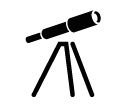
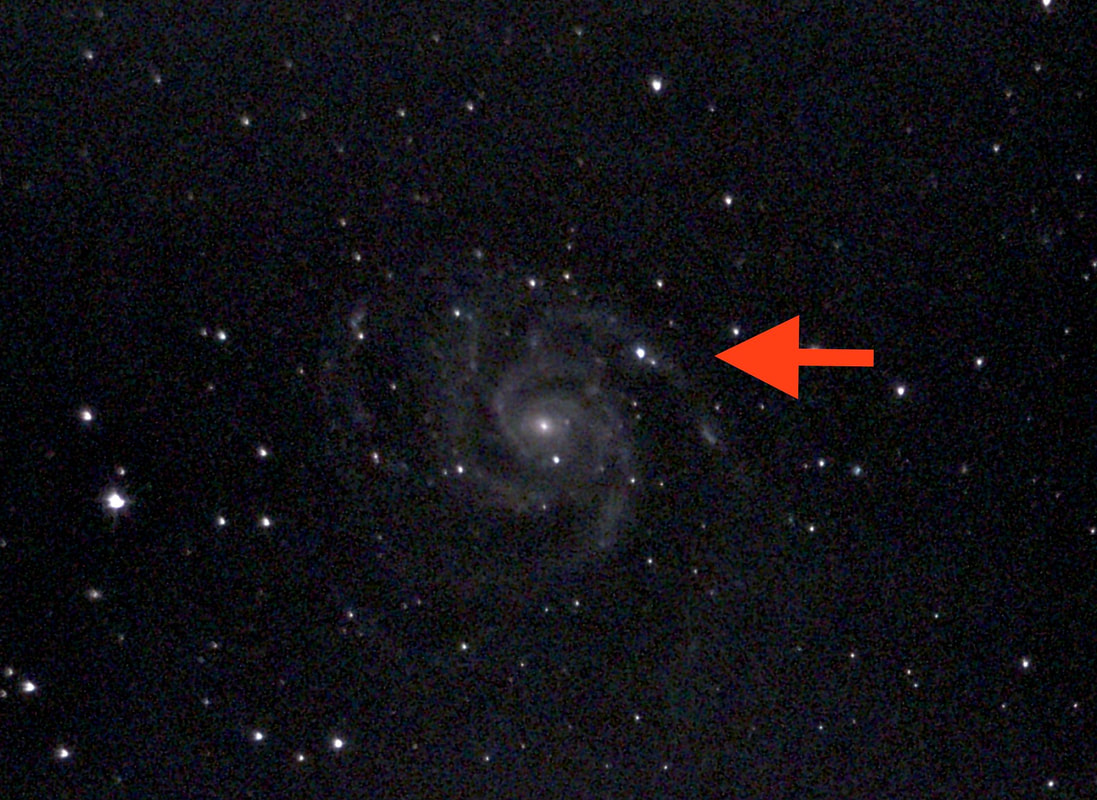
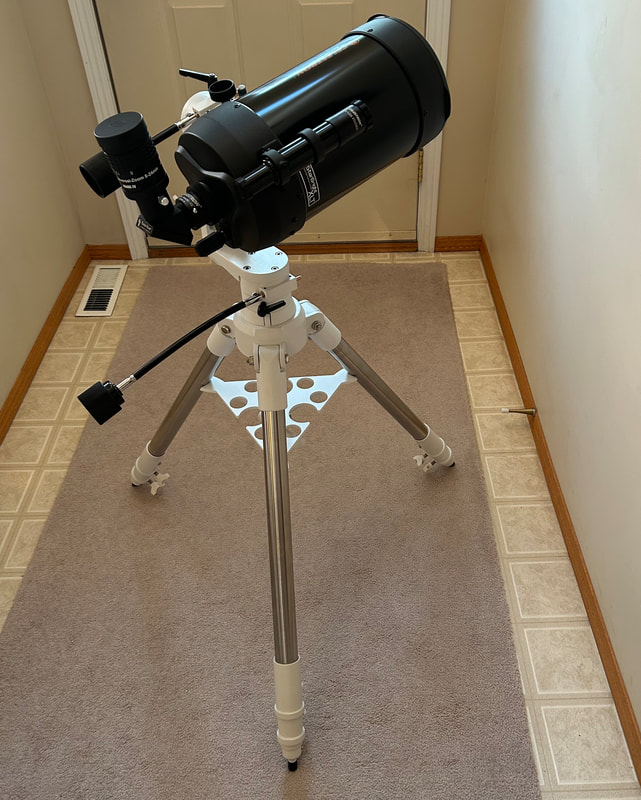
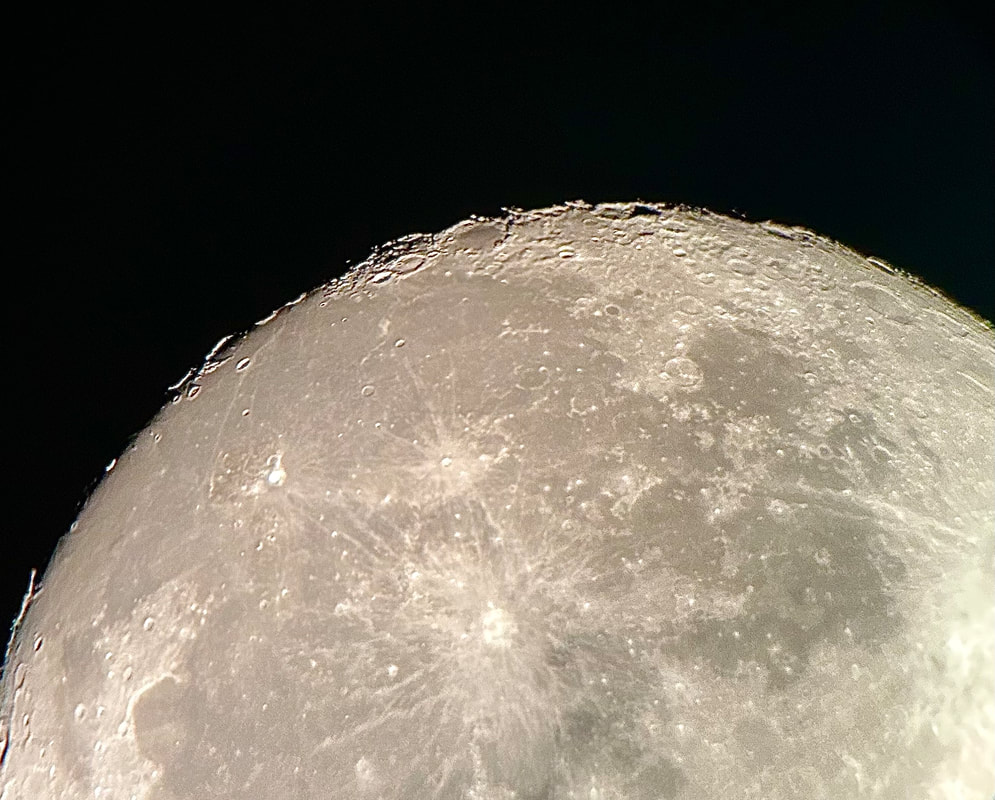
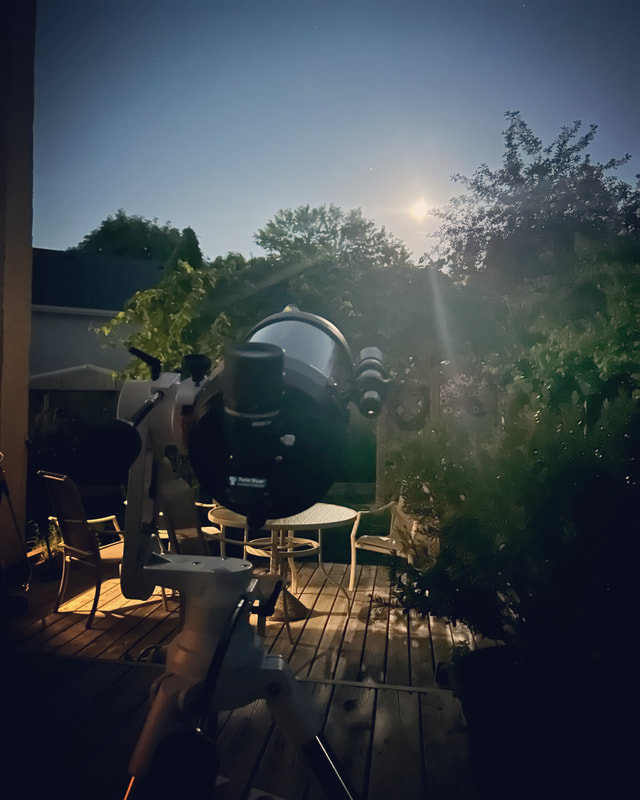
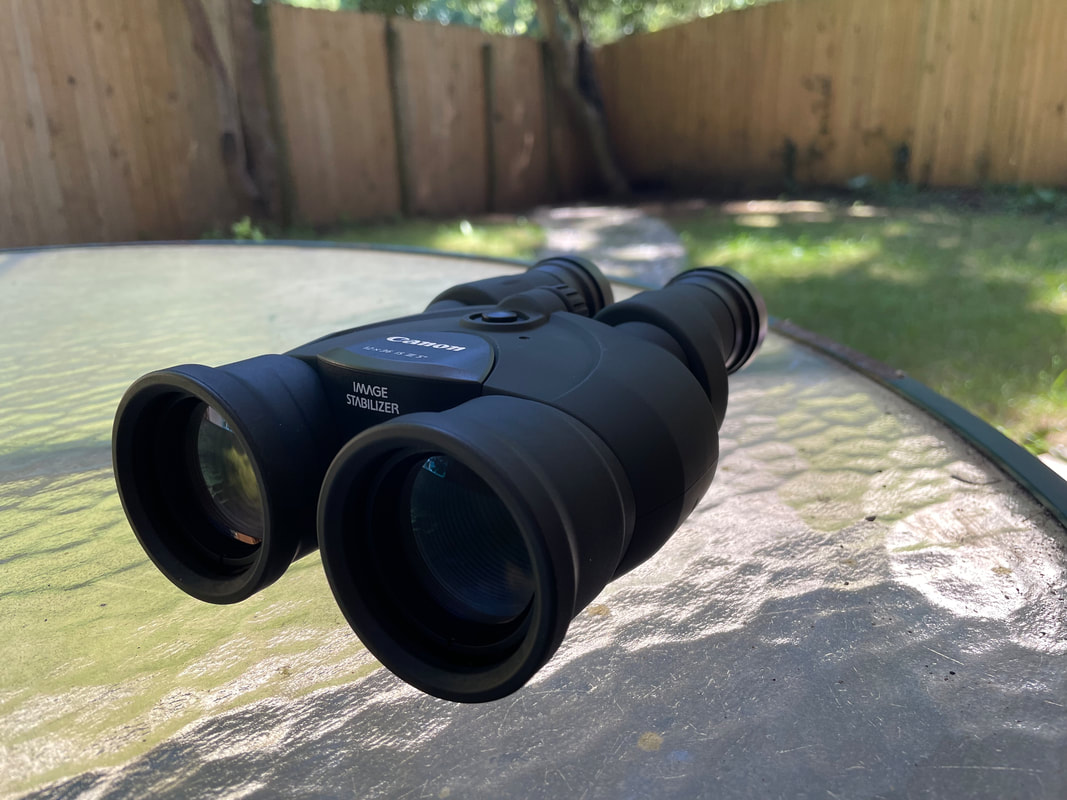
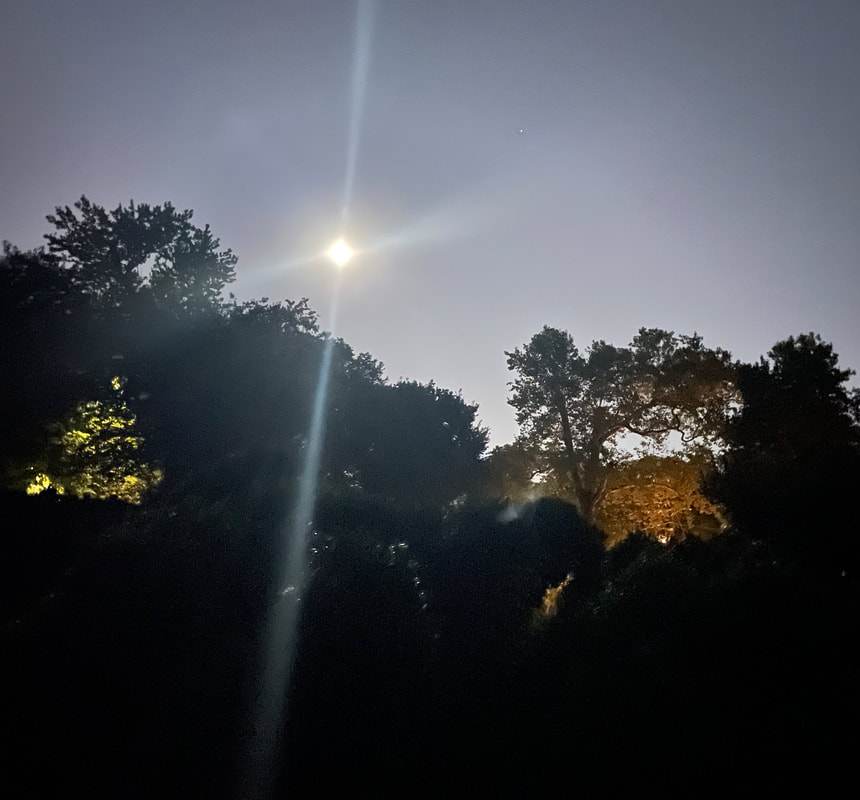
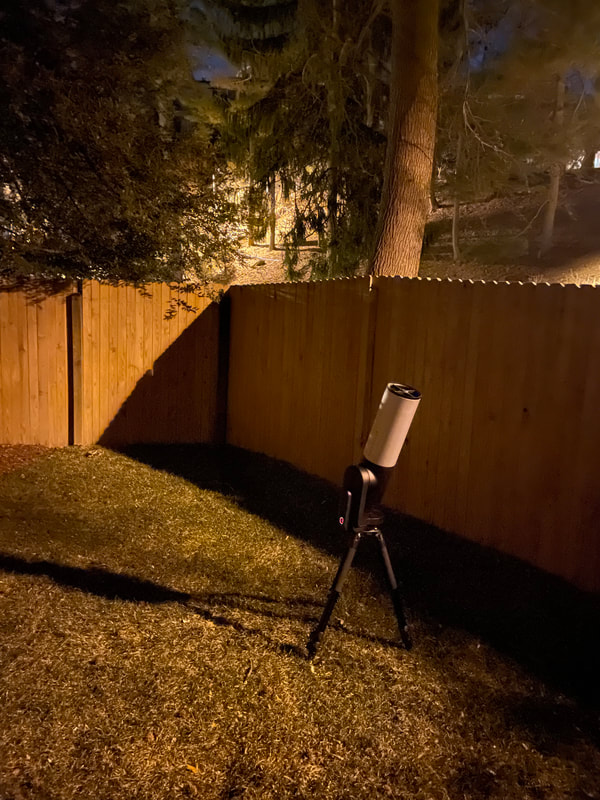
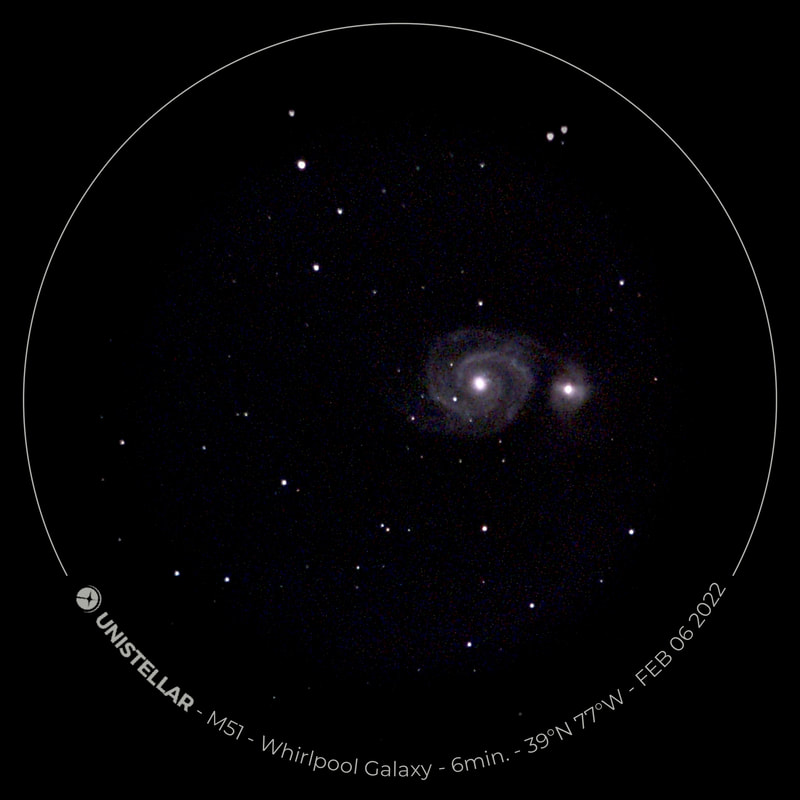
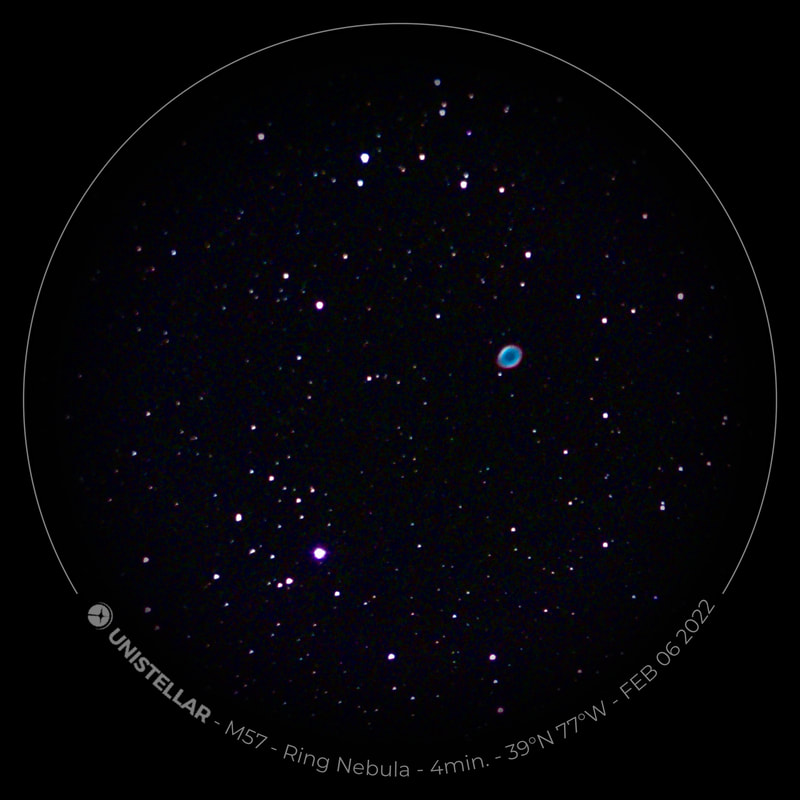
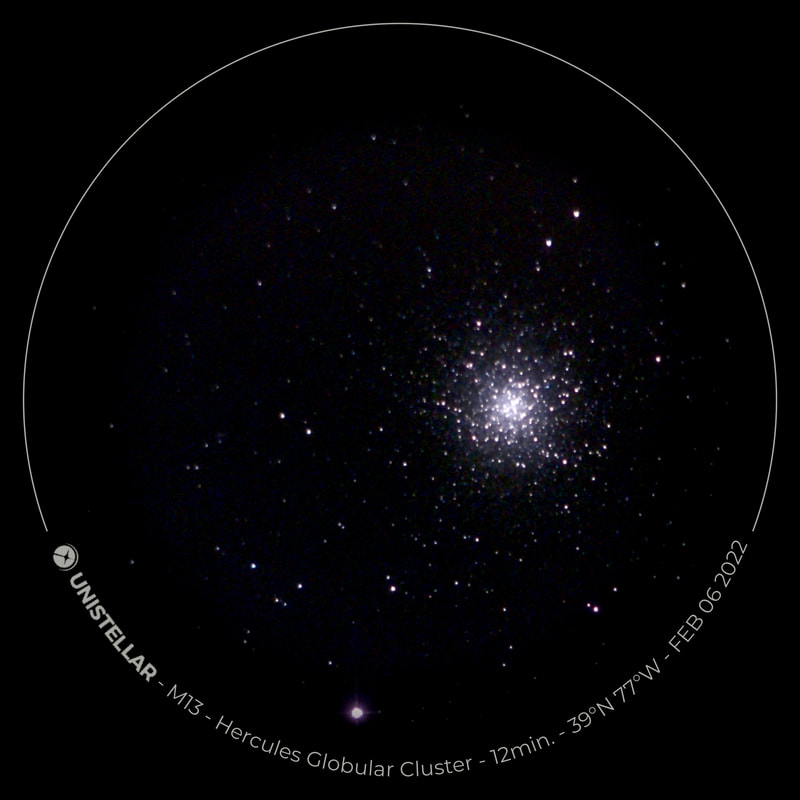
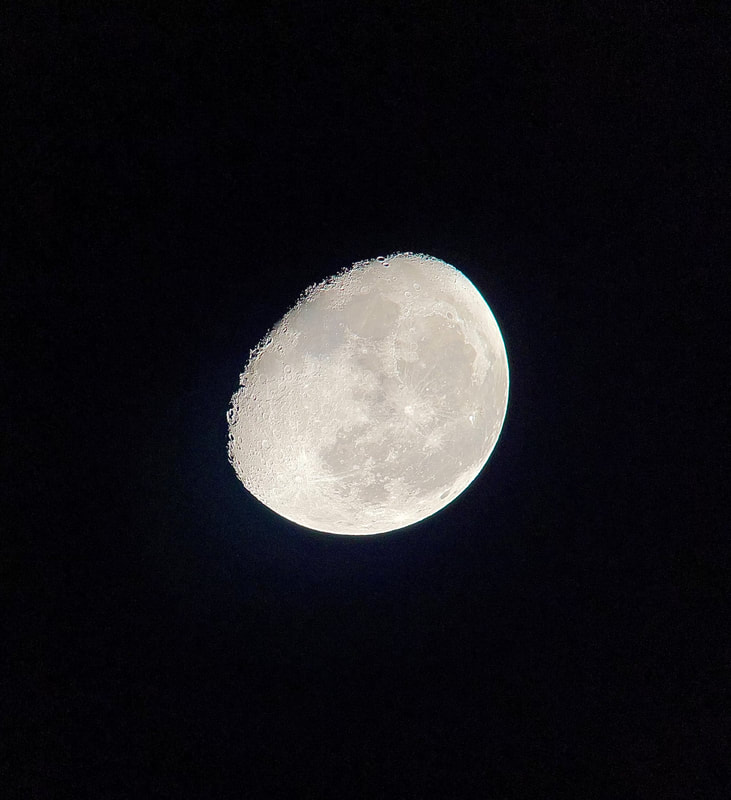
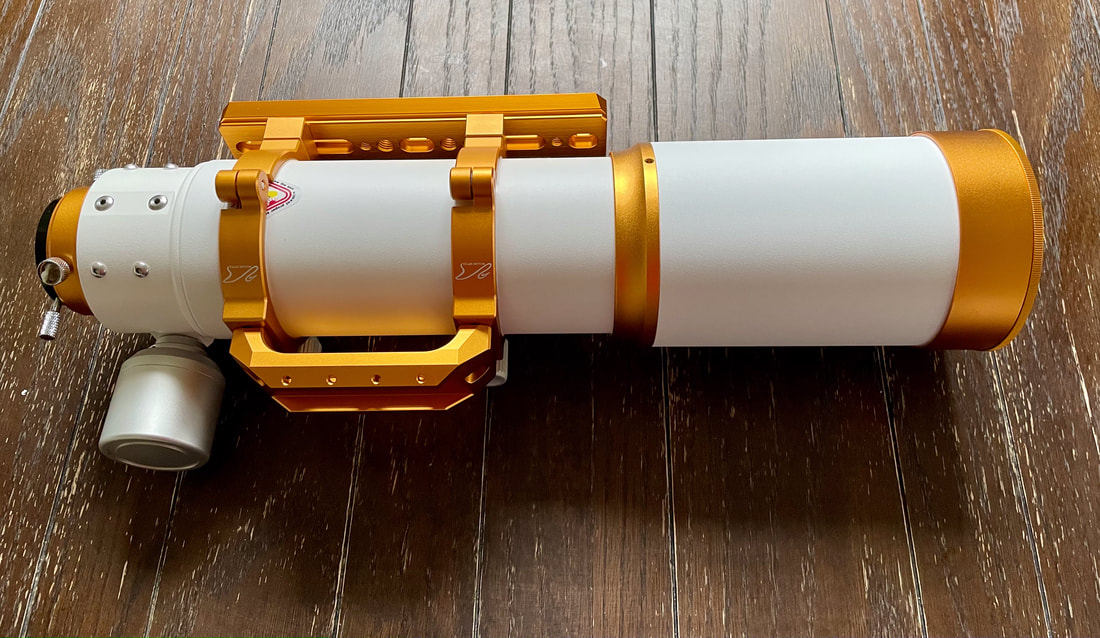
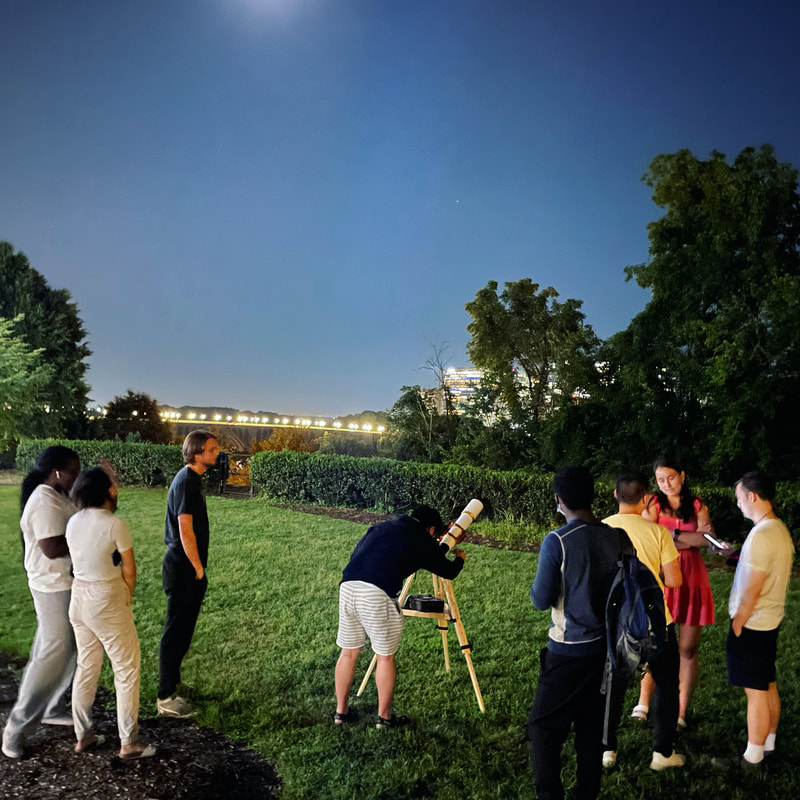
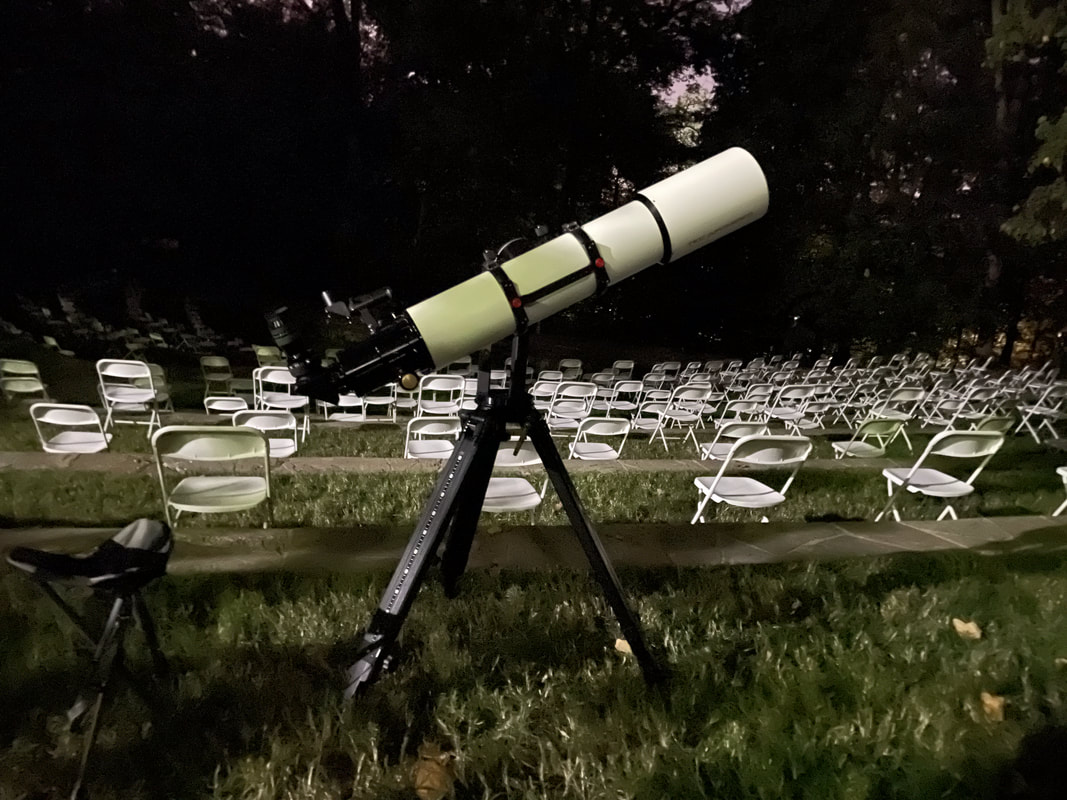
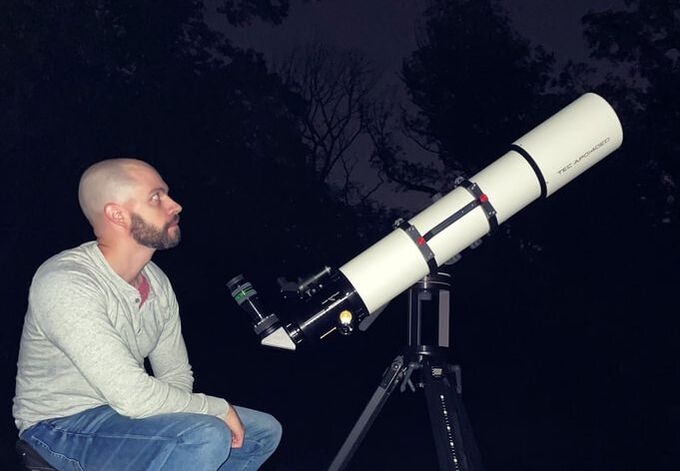
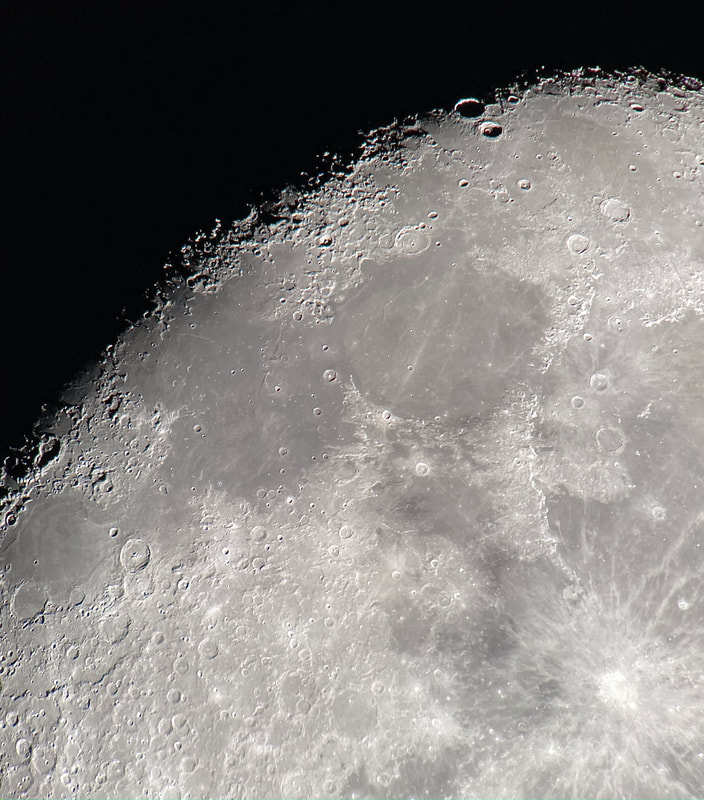
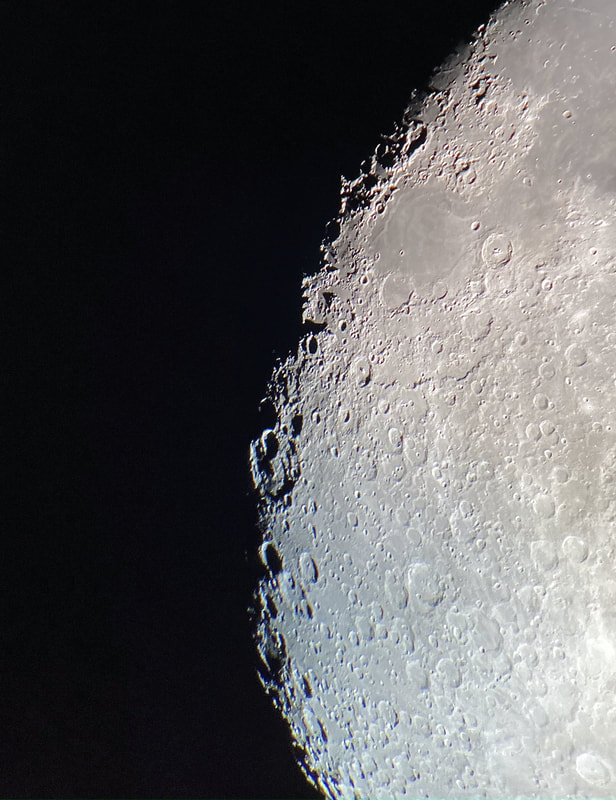
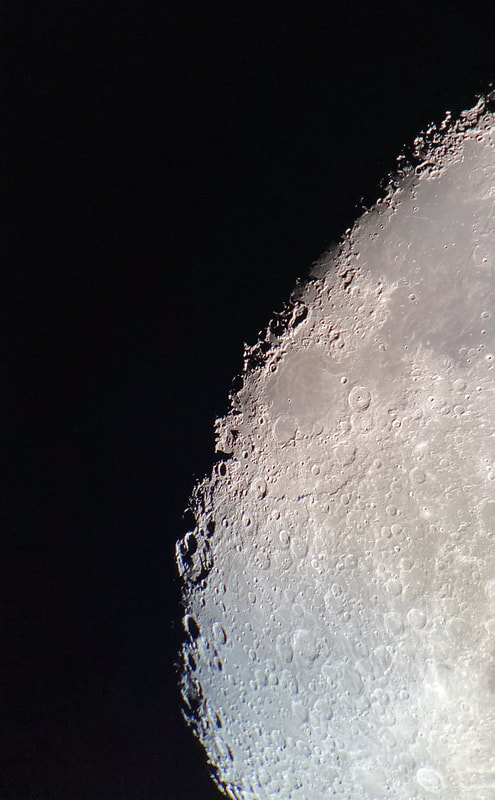
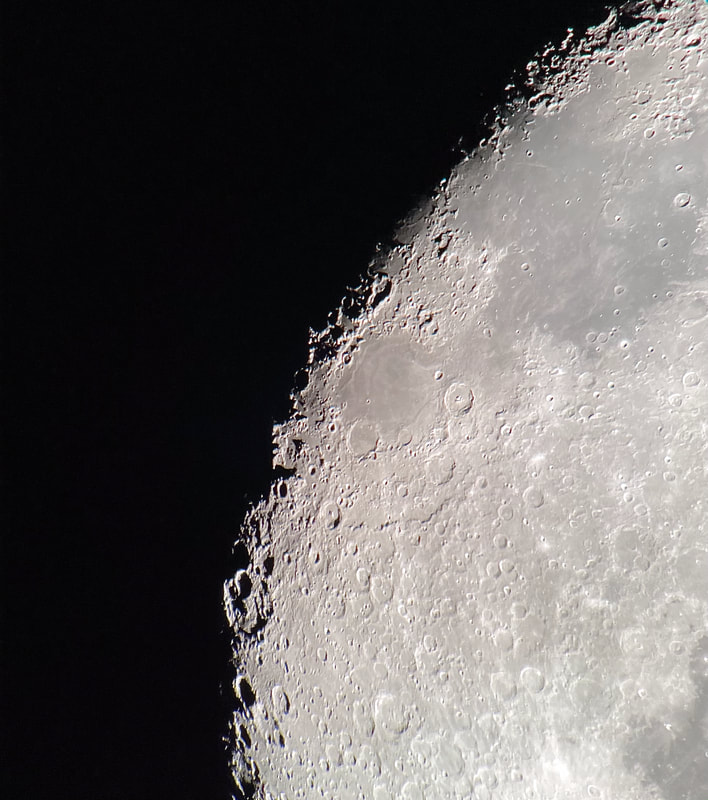
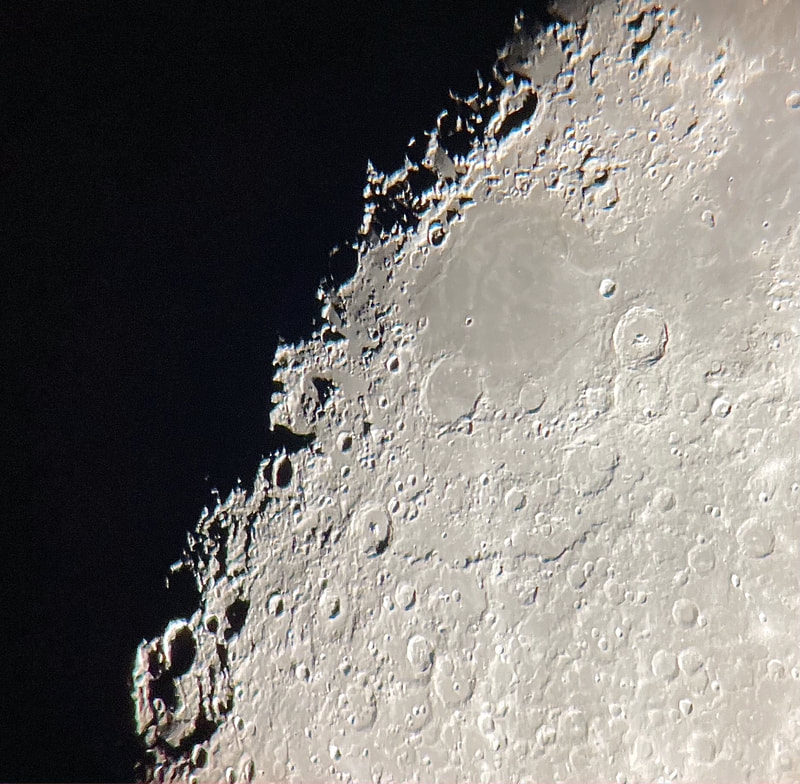
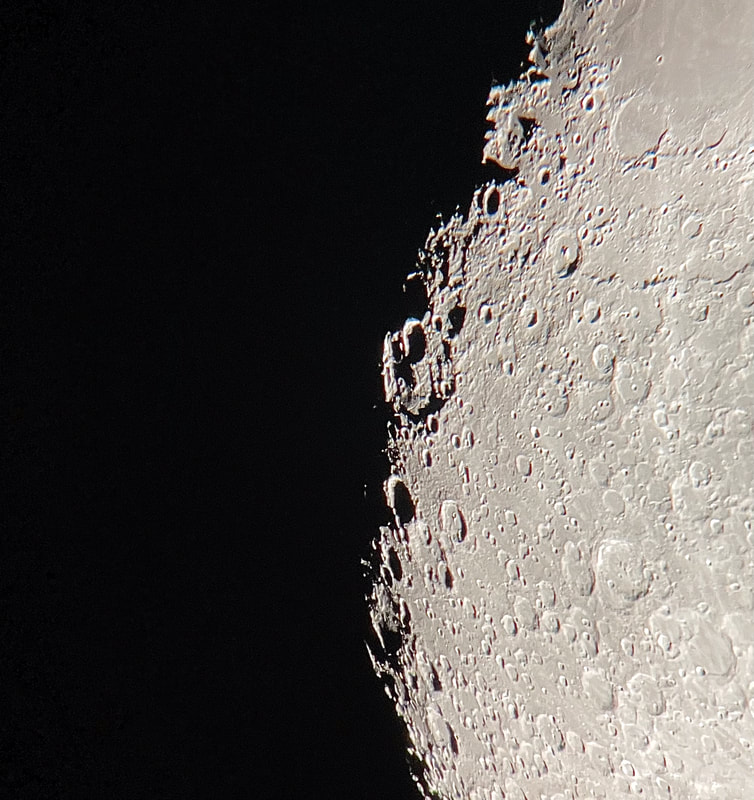
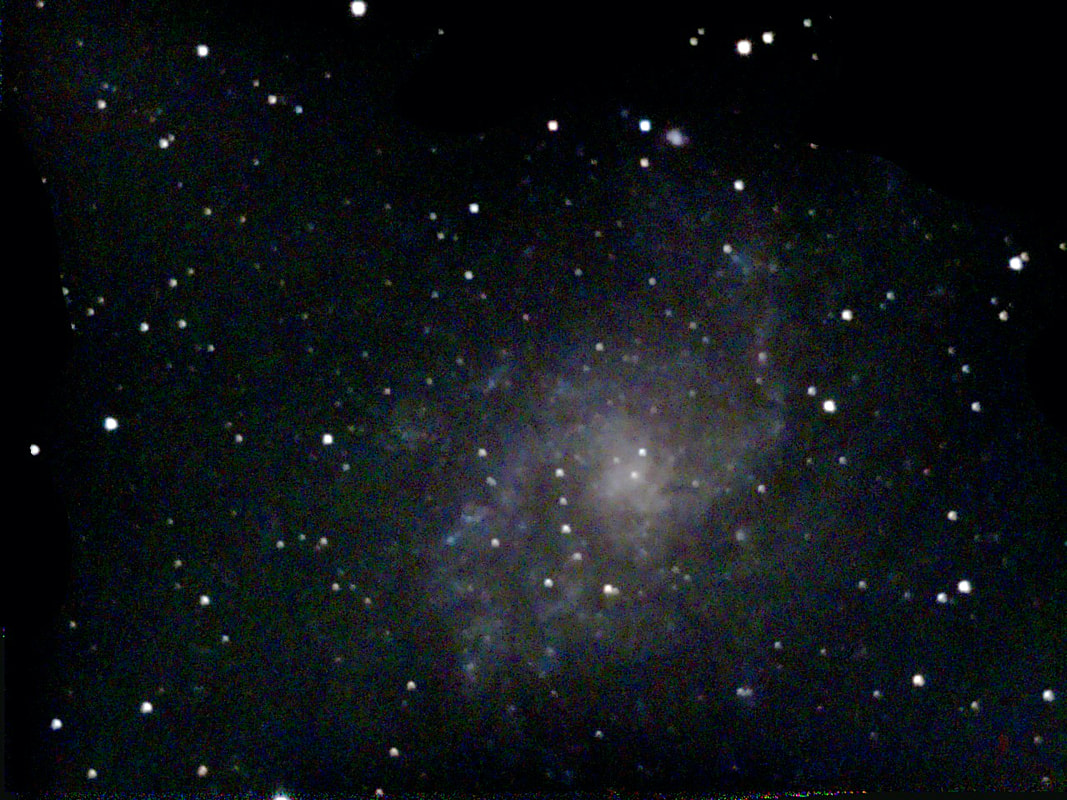
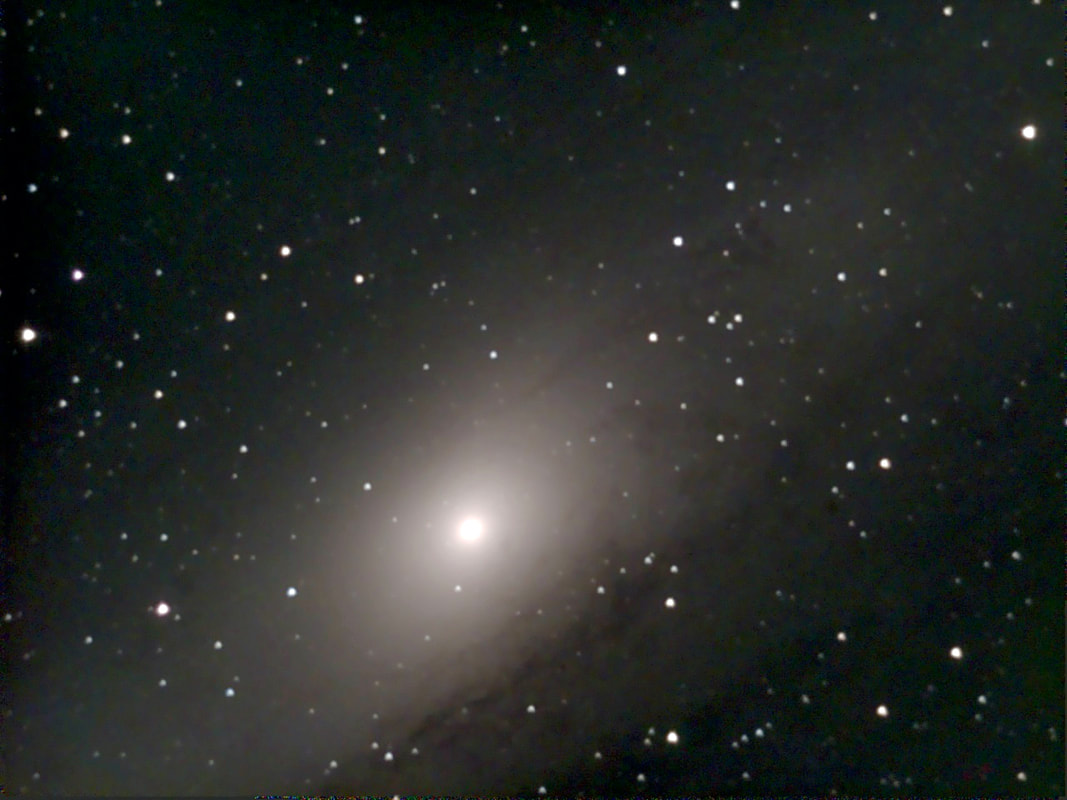
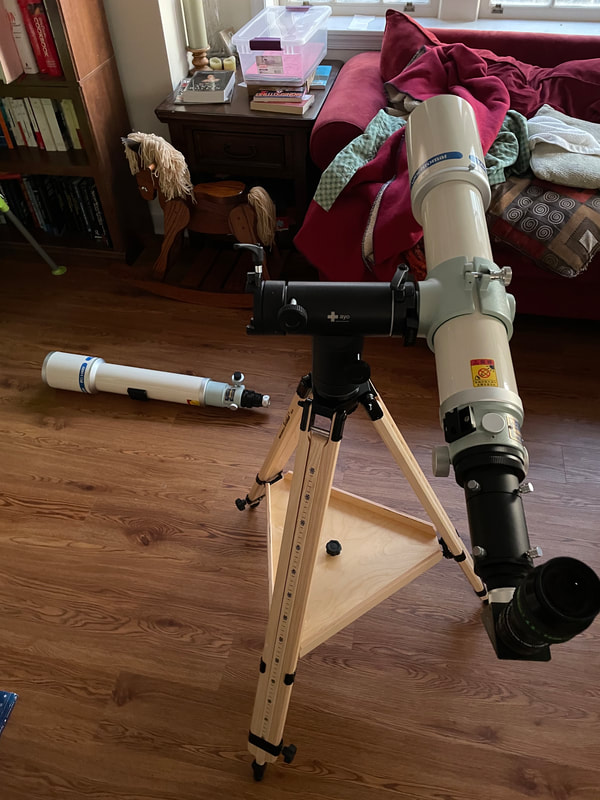
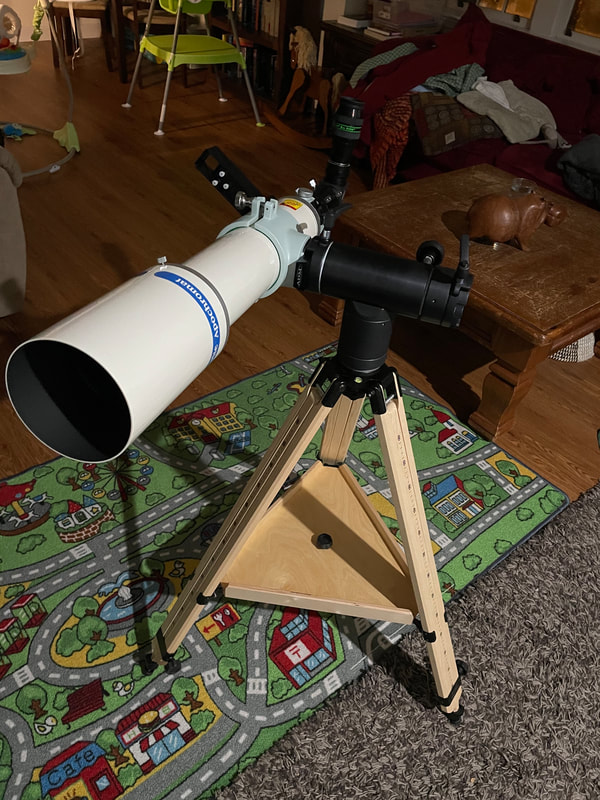
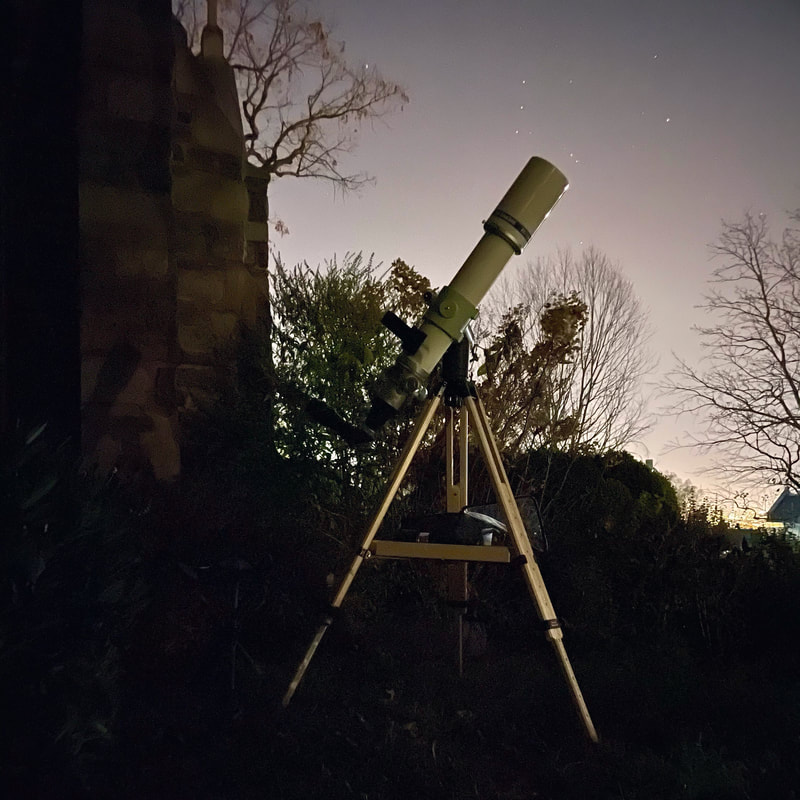
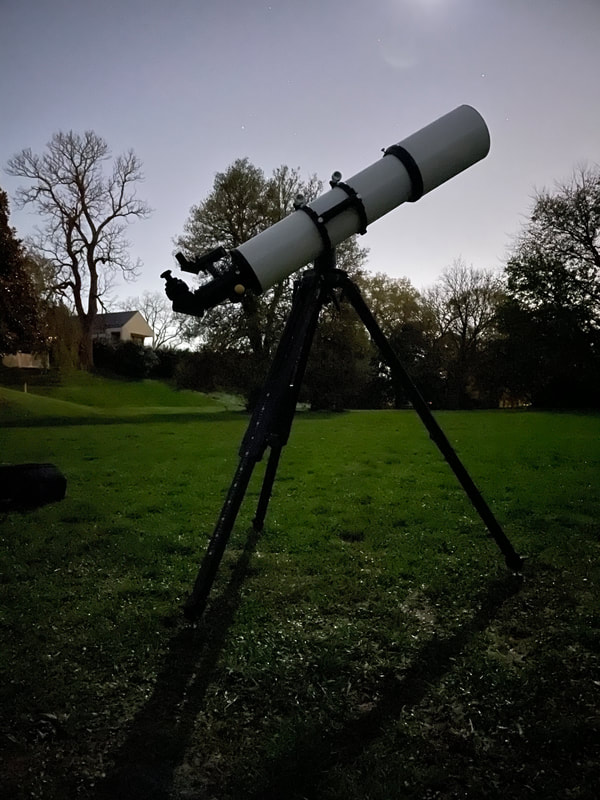
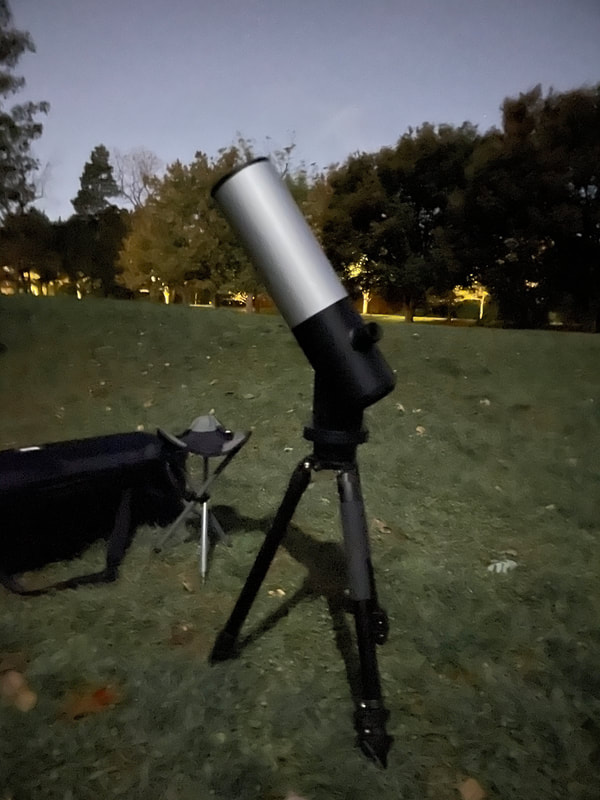
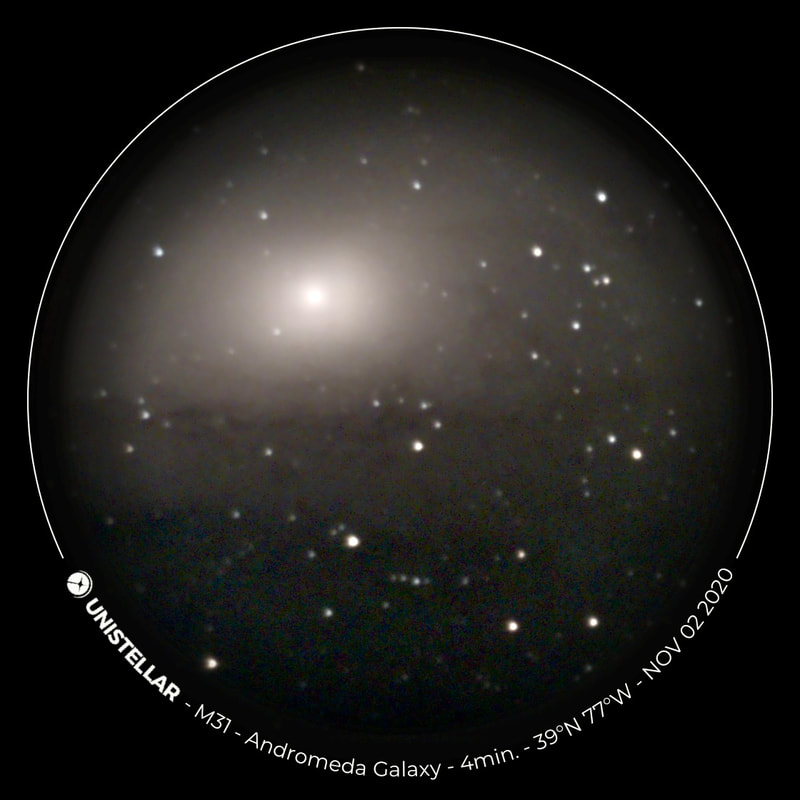
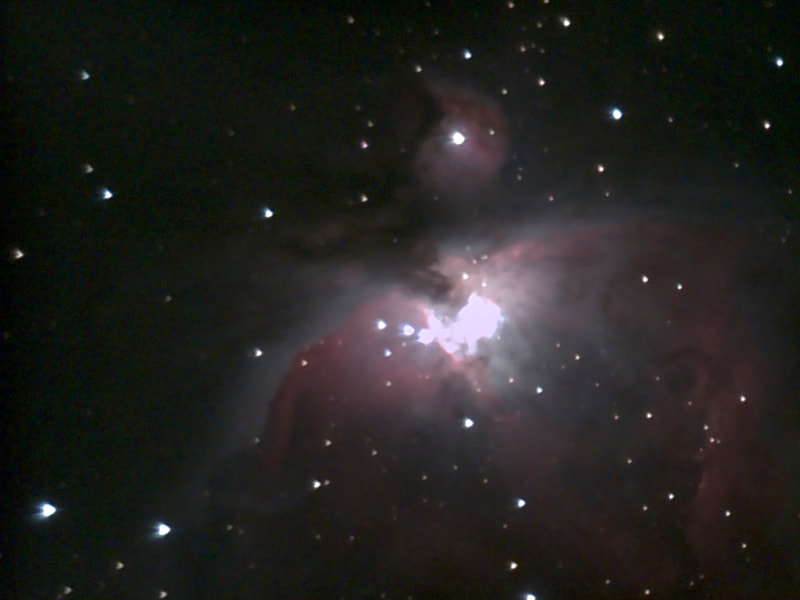
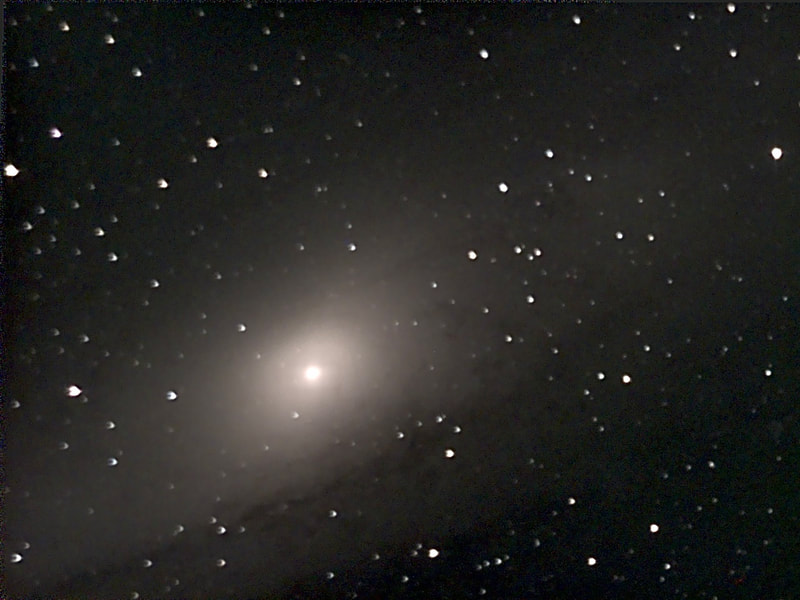
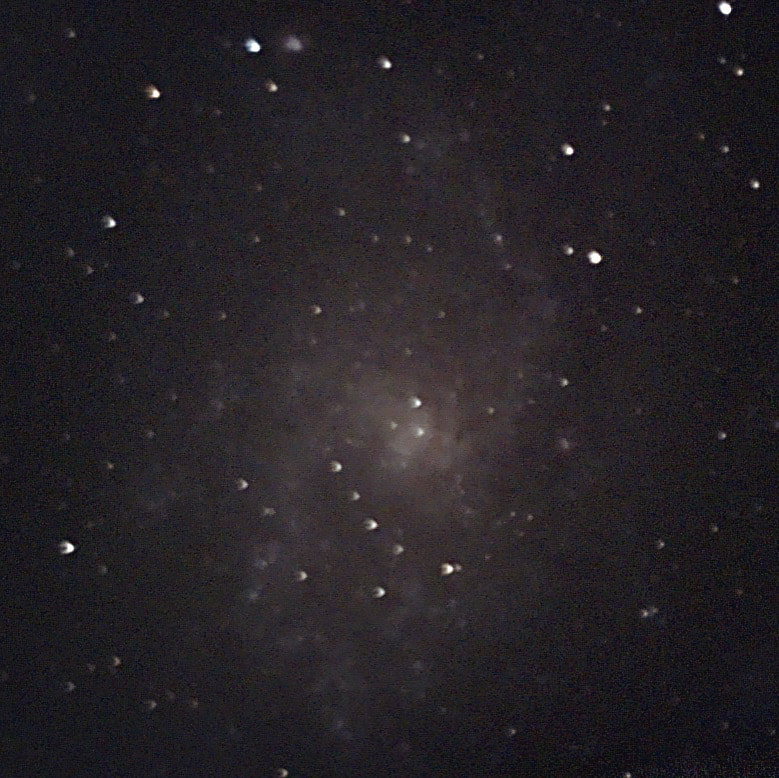
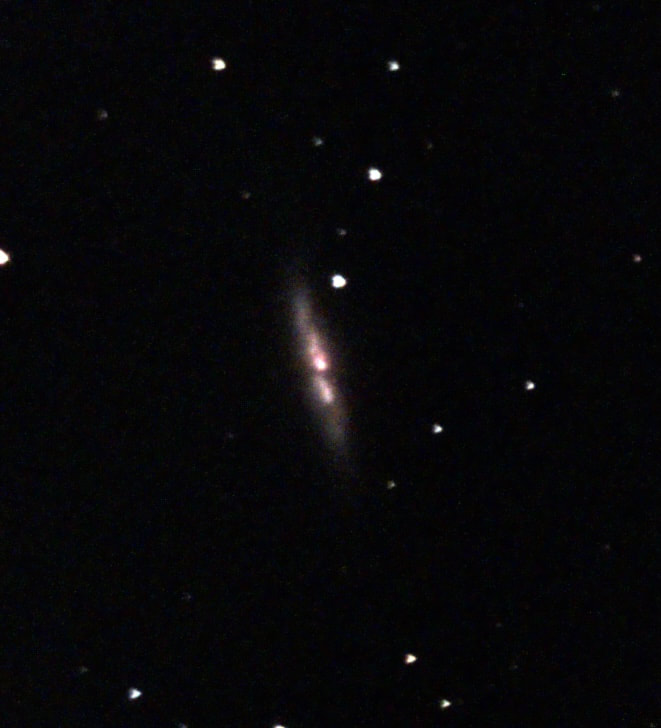
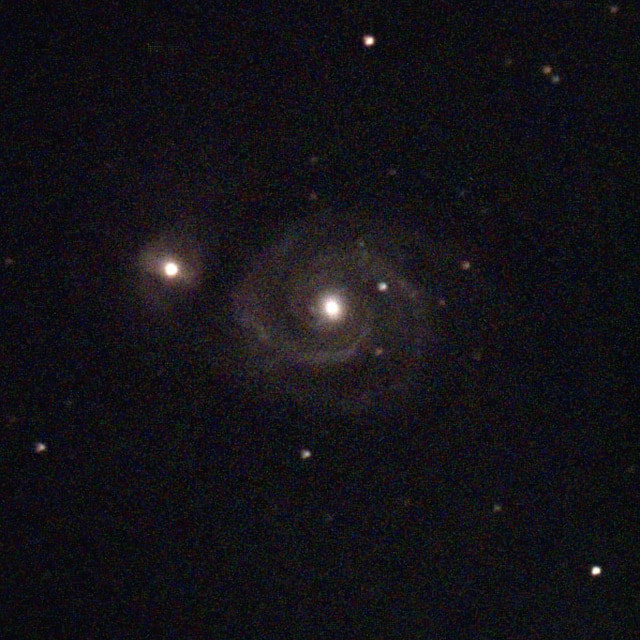
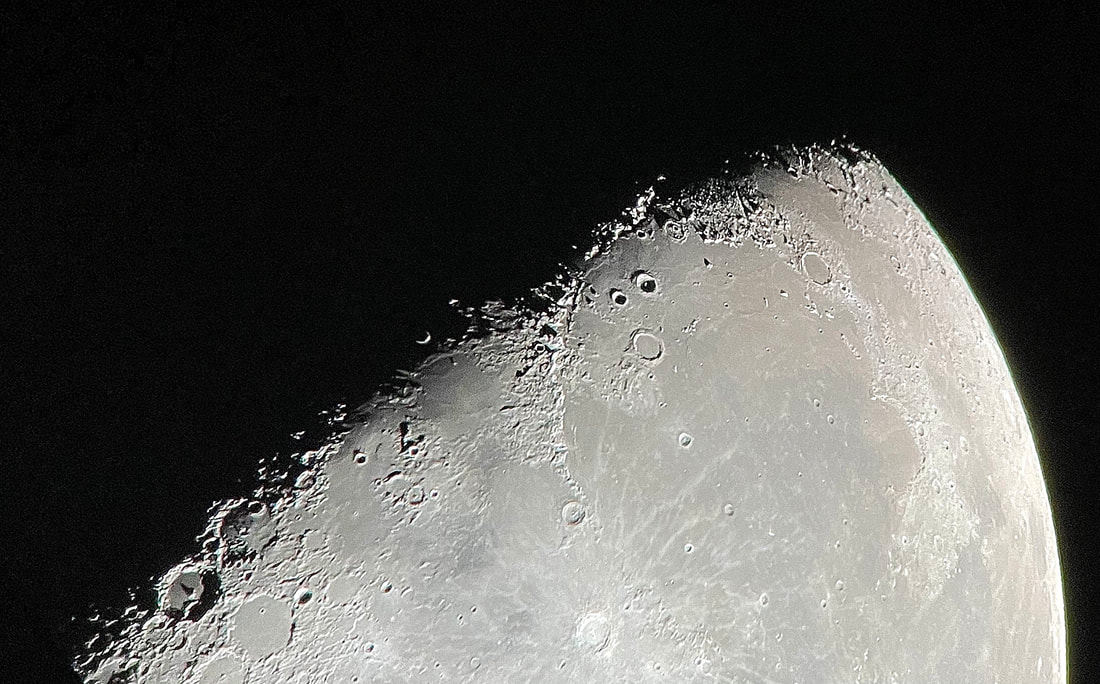
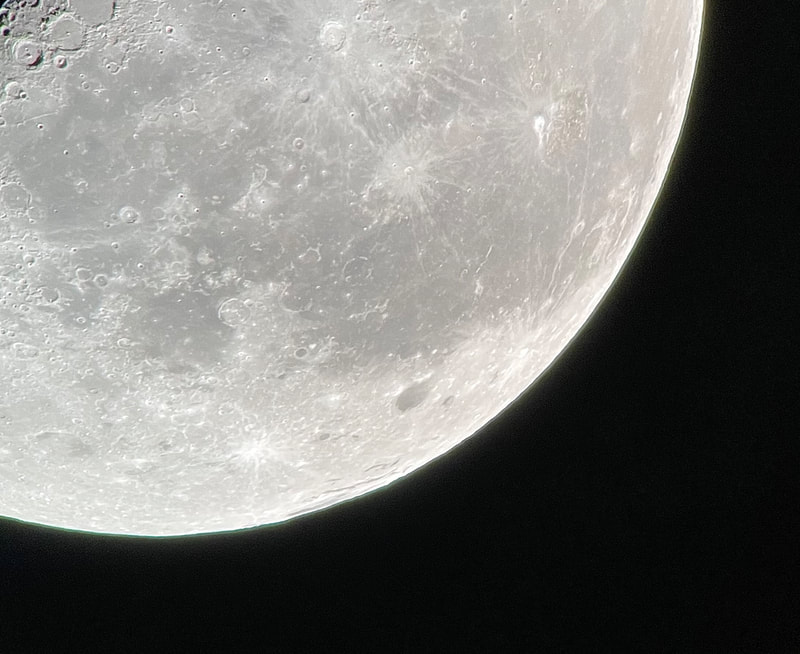
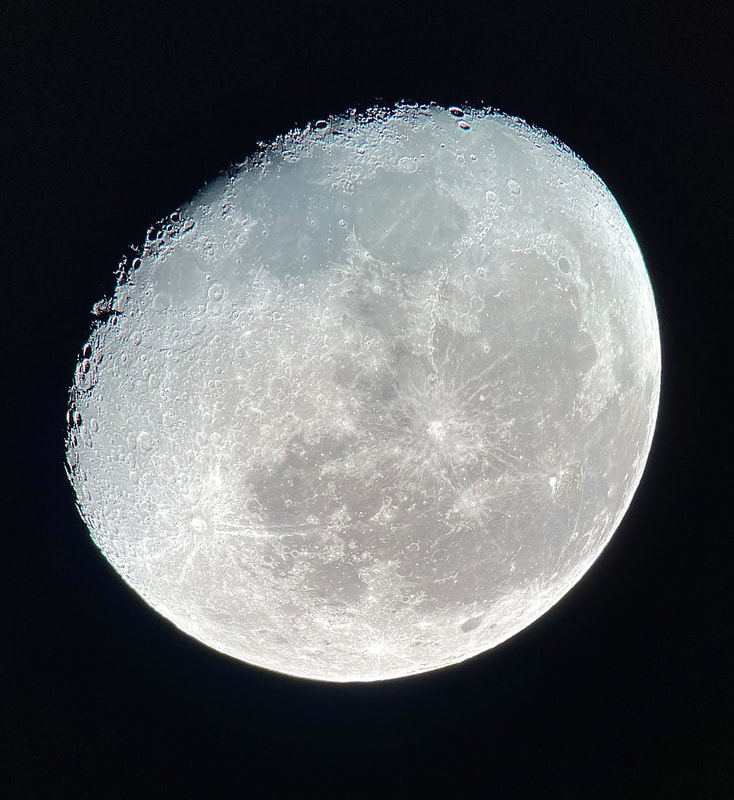
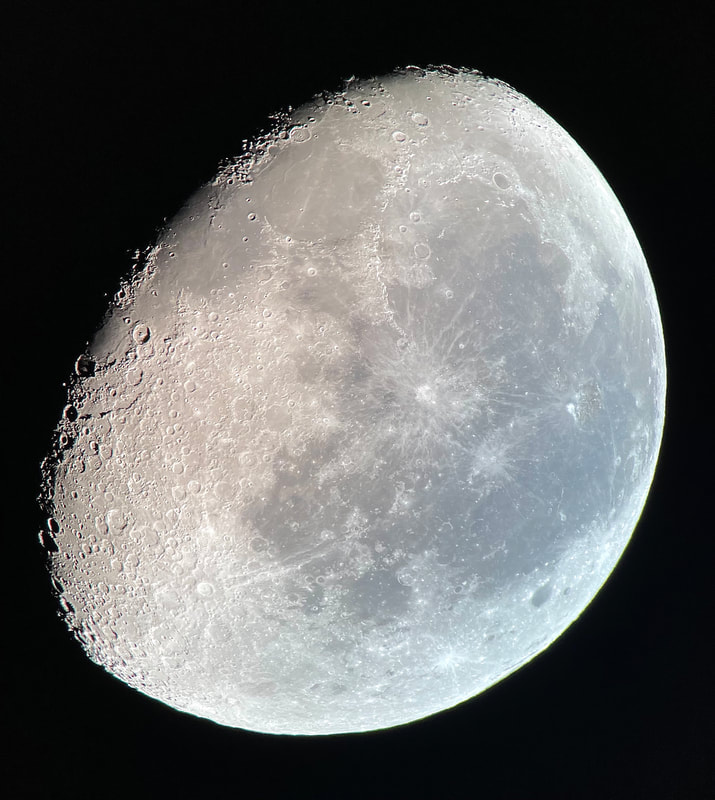
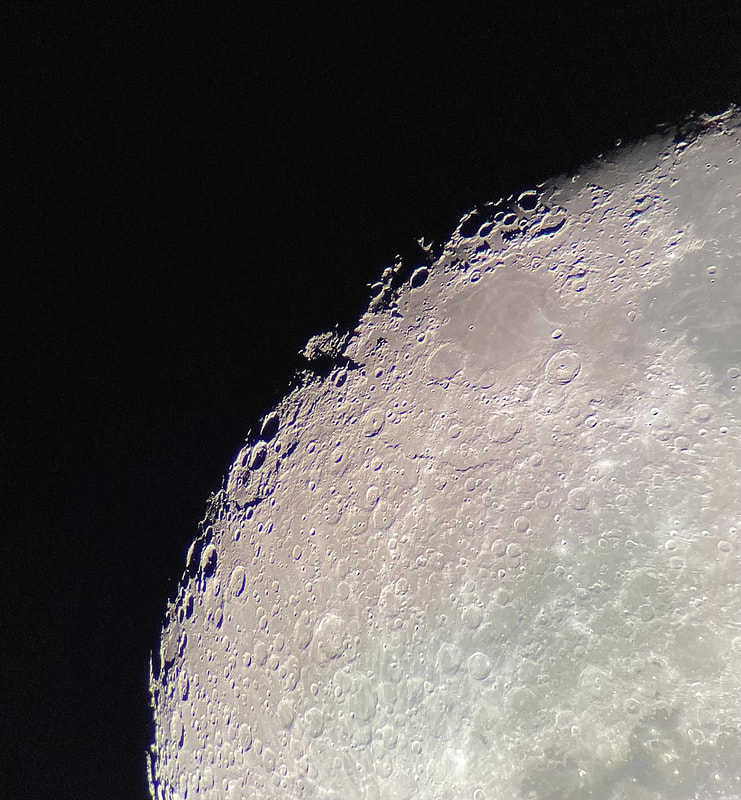
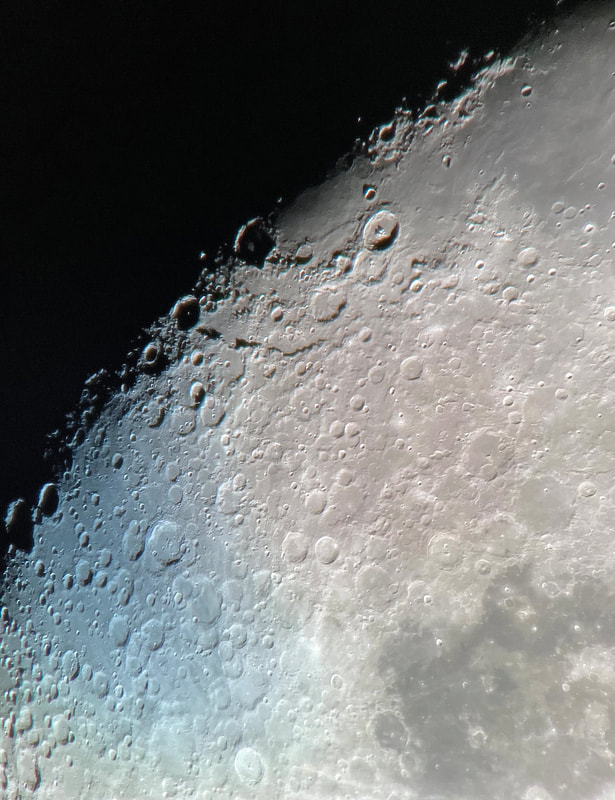
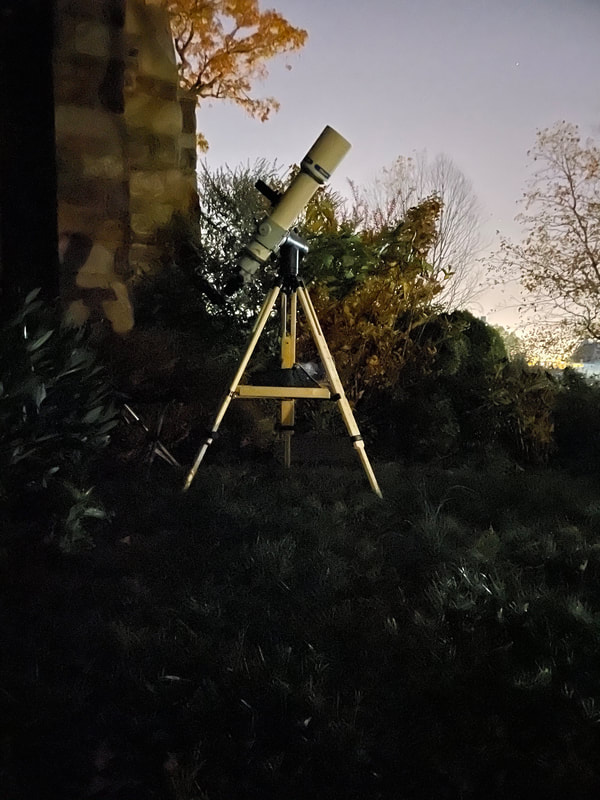
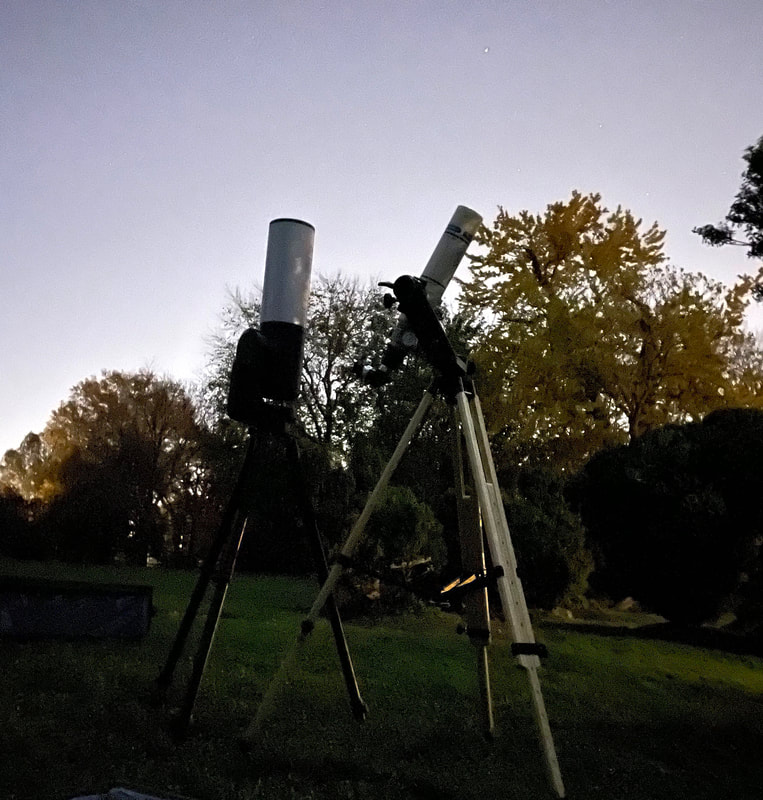
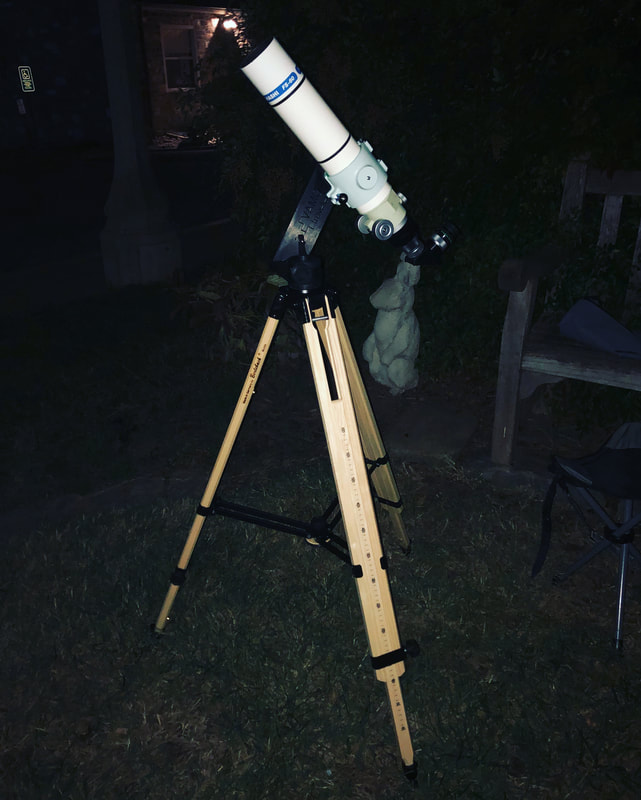
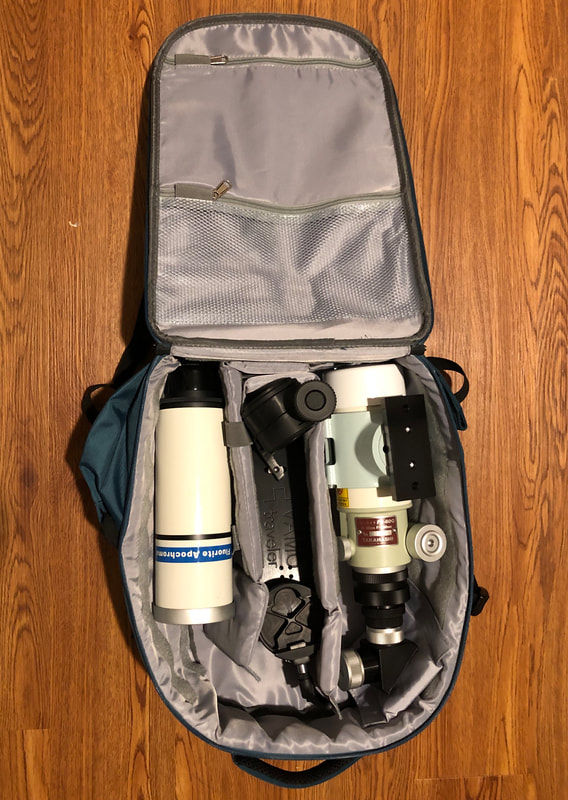
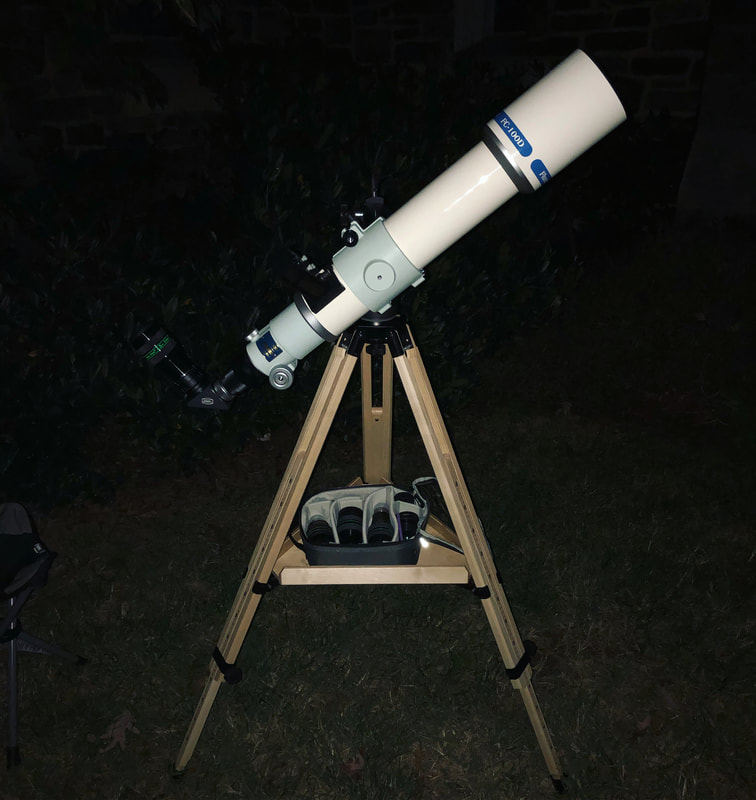
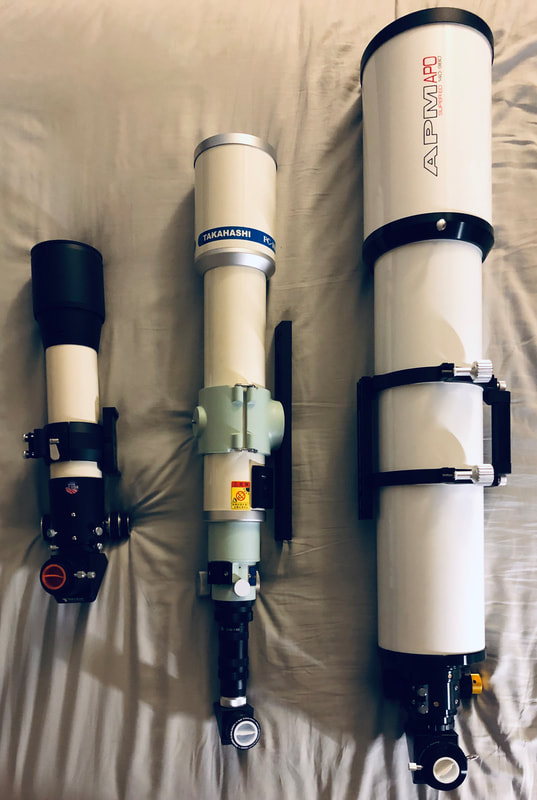
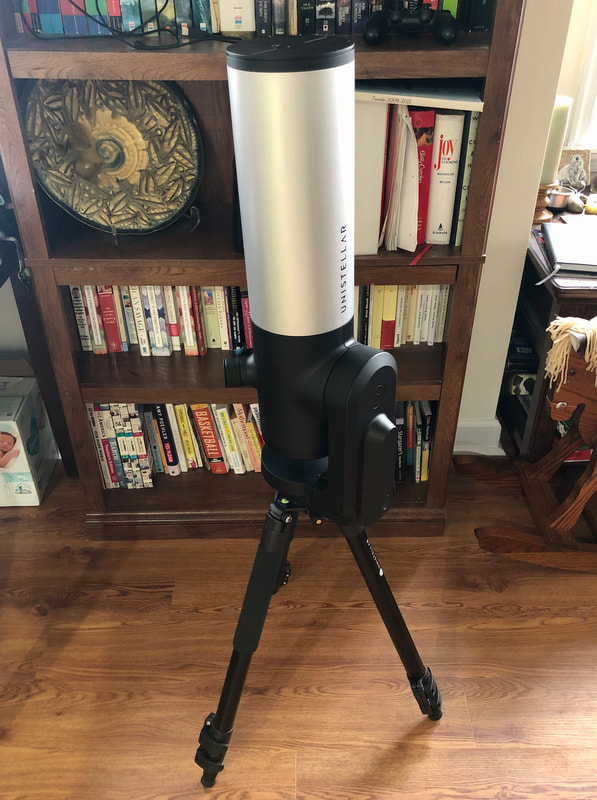
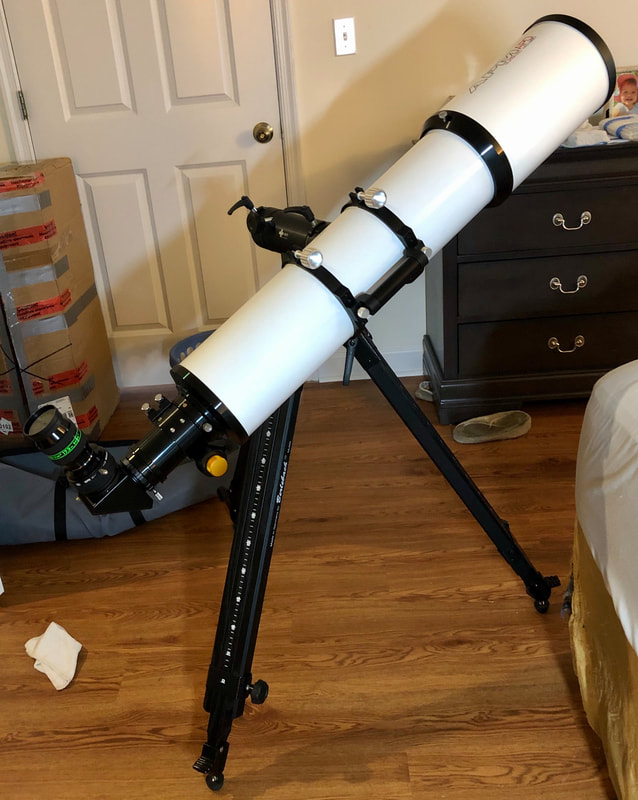
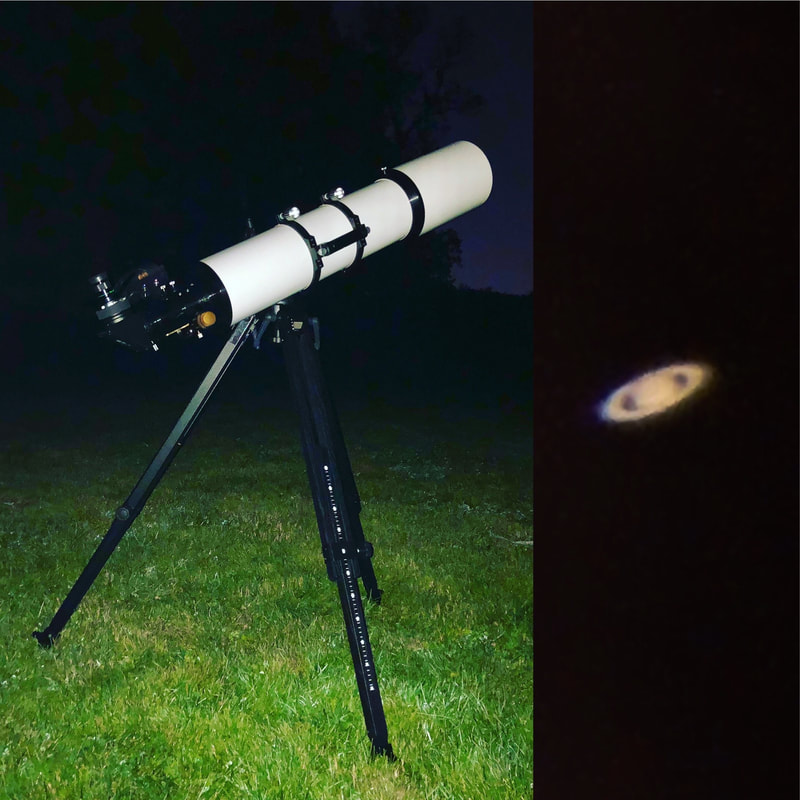
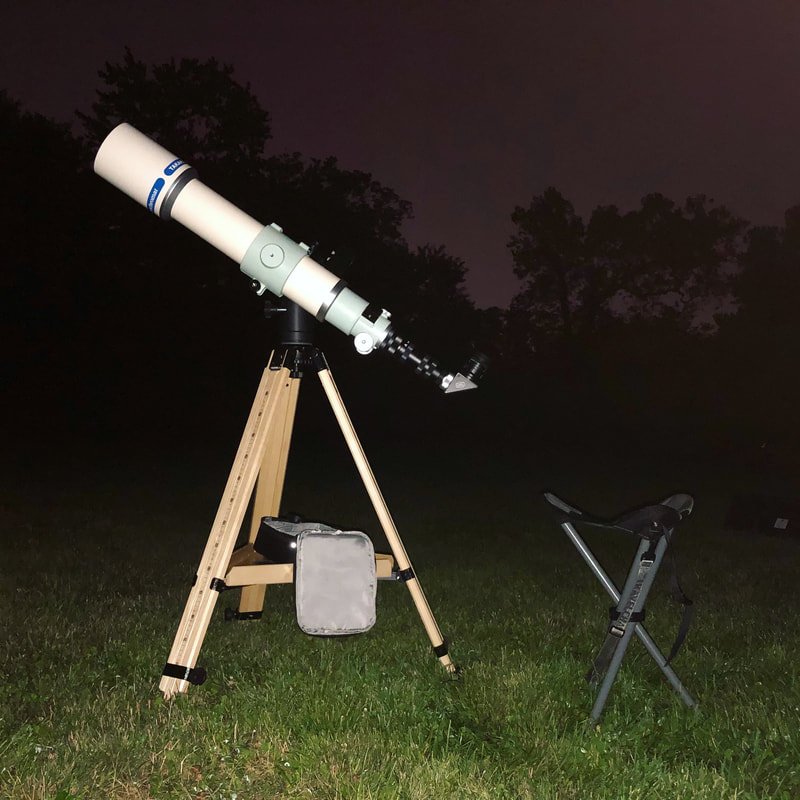
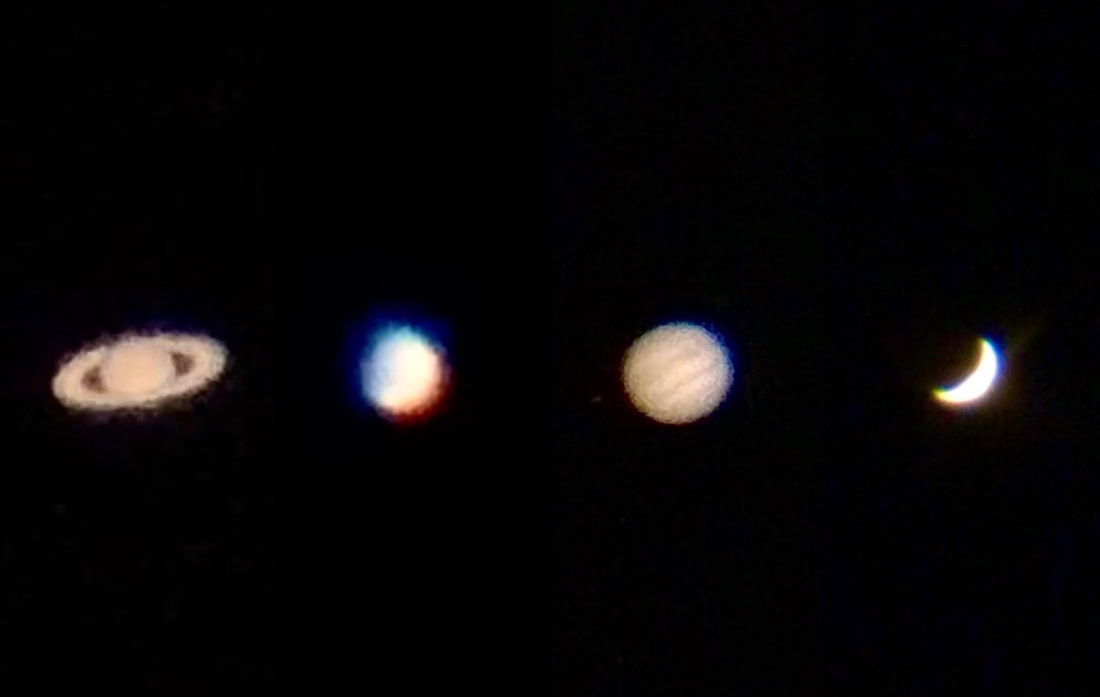
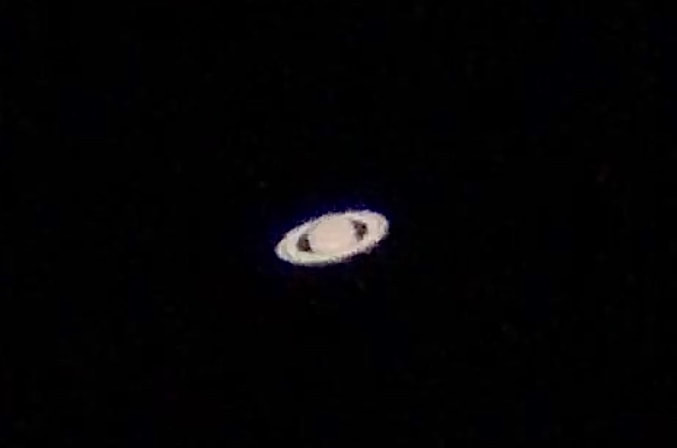
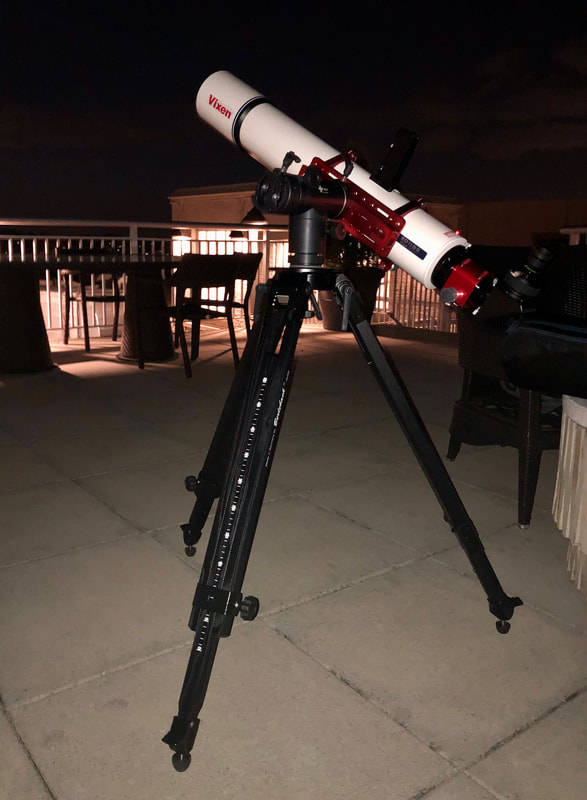
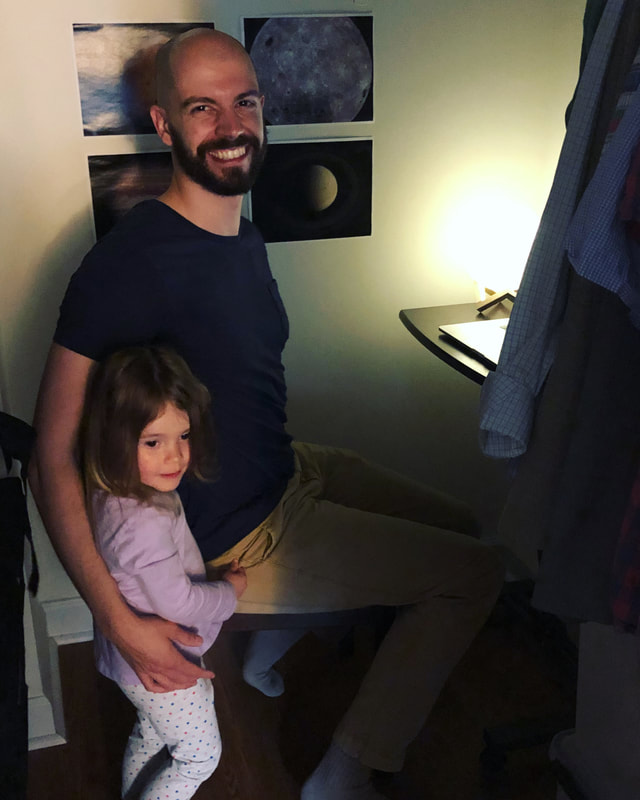
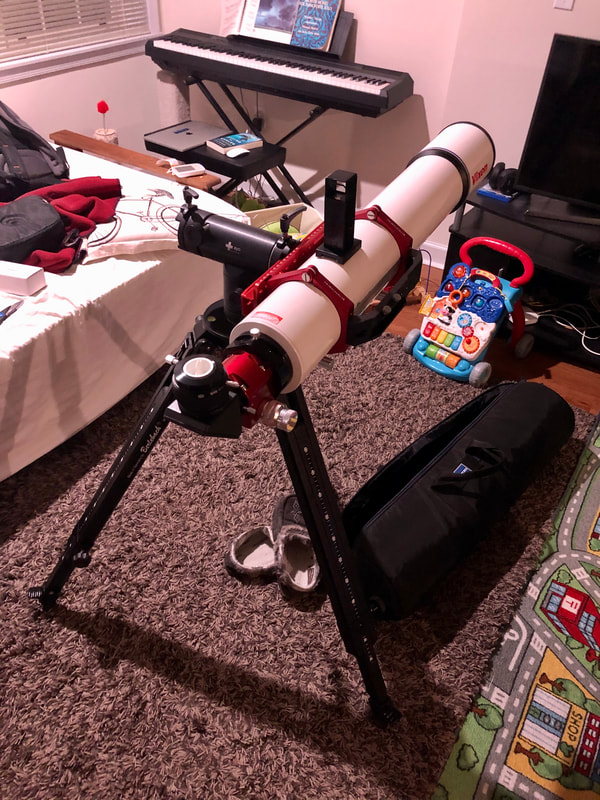
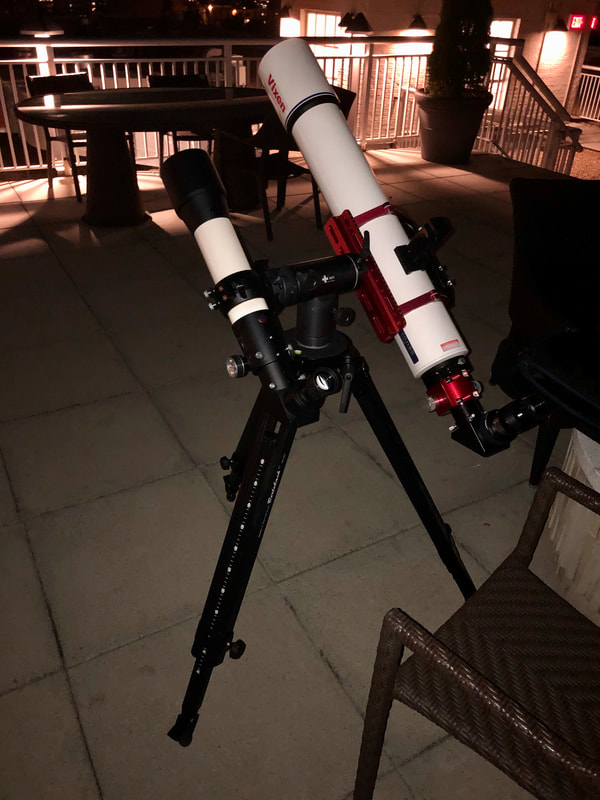
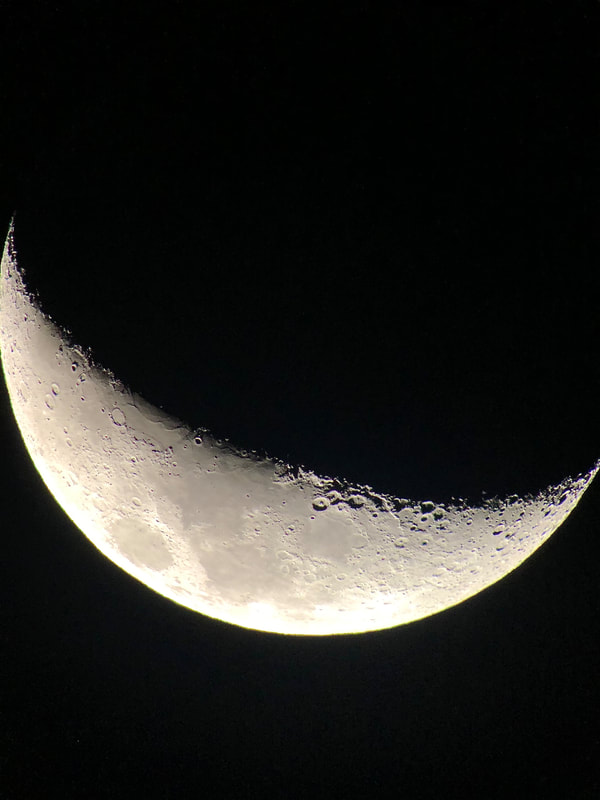
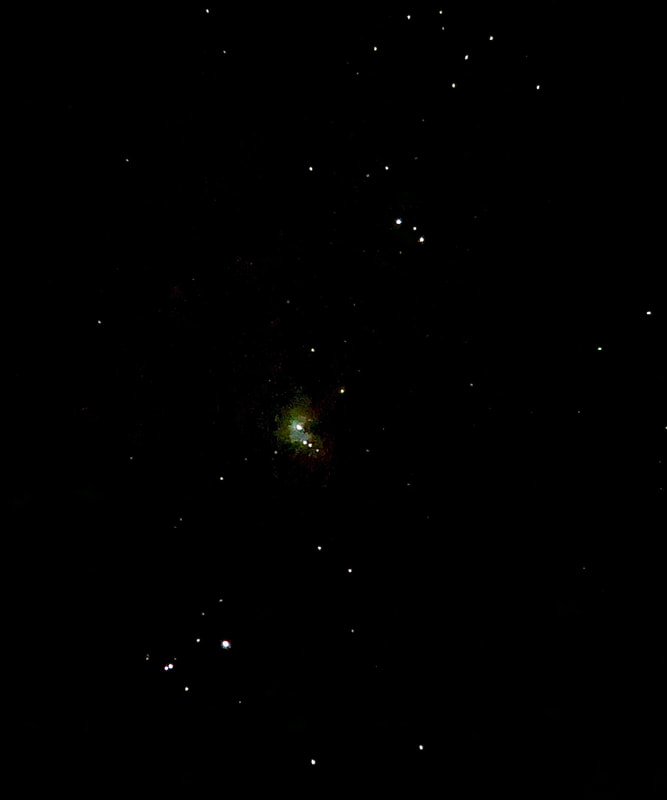
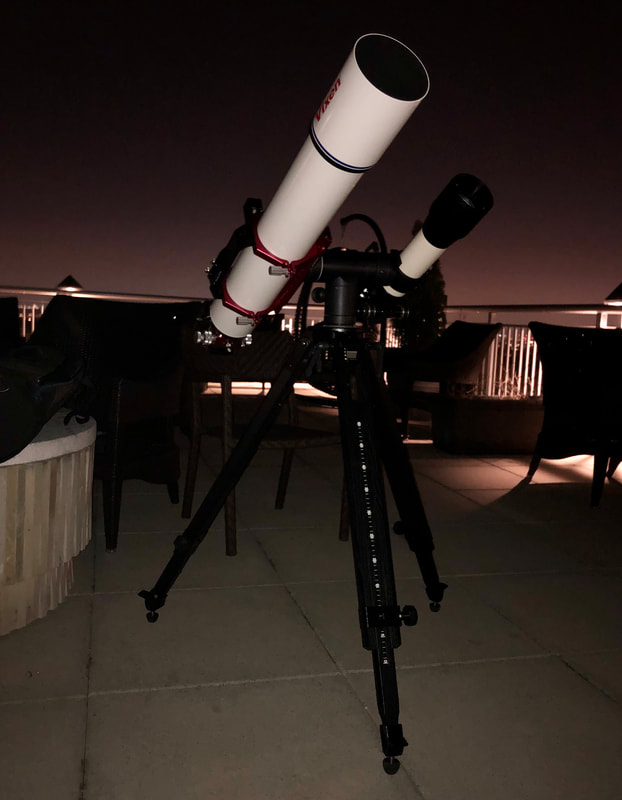

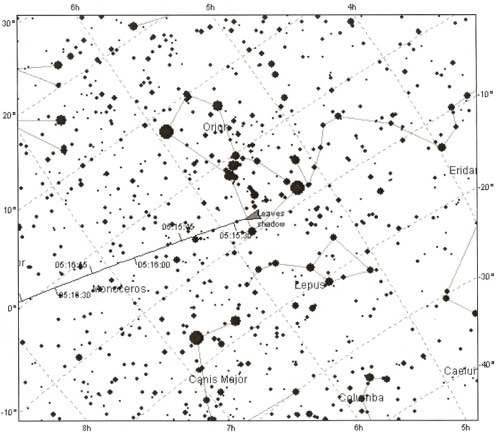
 RSS Feed
RSS Feed